
Please send all Checks and Money orders to :
Dave Taylor P.O. Box 87 Sylvania, OH 43560
419-842-1863
Click Here to E-mail Us!
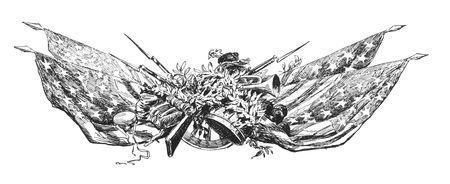

16-04-01
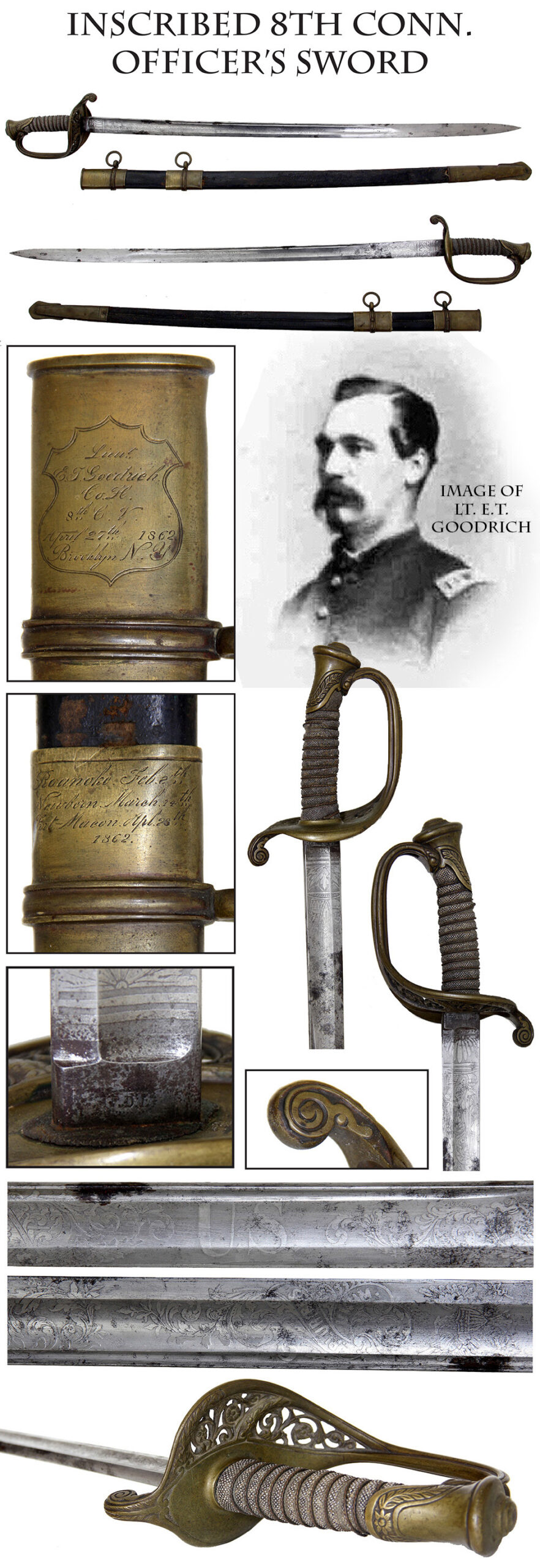
16-04-01 … WOUNDED-IN-ACTION 8th CONNECTICUT INSCRIBED OFFICER’S SWORD WITH BATTLE HONORS …
Regulation 1850 pattern foot officer’s sword. Upper mount inscribed inside a shield: “Lieut. / E.T. Goodrich / Co. H / 8th C.V. / April 27th 1862 / Brooklyn N.Y.” Also inscribed with battle honors on the upper portion of the middle mount: ” Roanoke Feb. 8th / Newbern March 24th / Fort-Macon Apl. 25th / 1862.” Drag is in place and patina matches throughout. Hilt complete with sharkskin grip wrap and single wire binding: one break in the wire about three turns down. Etched blade with floral motifs and trophies of arms. Amid them a “U.S.” on one side and an American eagle with E Pluribus Unum ribband over head. Etching is very visible with a smattering of darker gray areas here and there and a little surface brown at the ricasso. “PDL” maker’s mark at the ricasso indicating a blade by Peter Lunenschloss, one of the more prolific suppliers to American military goods dealers, Tiffany among them. Blade with good edge and point. Scabbard solid with just some scattered abrasions and wear to the leather. Elam T. Goodrich enlisted at Meriden, Ct., and mustered into Co. K of the 8th Connecticut as a private on 11/1/1861. He made corporal 3/15/62 and 2nd lieutenant and was transferred to Co. H on 4/7/62. He was promoted again, to 1st lieutenant in Co. B on 10/30/62, and finally to captain of Co. H on 4/1/1863. While serving at that rank he was wounded in action at Petersburg on 7/1/1864. He mustered out on 11/28/1864. The regiment’s first assignment was with Burnside’s expeditionary force to North Carolina, where Goodrich earned his first battle honors. It then transferred to Virginia and the Army of the Potomac as part of the 9th Corps, where was heavily engaged at Antietam, losing some 33 killed and 159 wounded. After a brief stint in the 7th Corps, Department of Virginia, in mid-1863 it joined the 18th Corps, which became part of the Army of the James and fought at Walthall Junction, Drewry’s Bluff and took part in the assault at Cold Harbor. The regimental history records that on its arrival at Petersburg it suffered twenty days under the fire of artillery and sharpshooters, listing Captain Goodrich as one of the casualties. Fox records their battle deaths as 8 officers and 112 enlisted men, giving it a reputation as one of the war’s fighting regiments. A good officer’s sword with battle honors and one received in time to be carried at Antietam and other engagements … noco … $3,250.00 – SOLD
Call us @ 419-842-1863

16-04-02 … EXTRA NICE BURNSIDE 5th MODEL CARBINE … Known sometimes from its receiver marking as the Model 1864, the Fifth Model improved on previous versions by the addition of a guide screw for the breechblock placed in the side of the receiver. This was, in fact, the standard model of the Burnside and was actually introduced in 1863, the 1864 date apparently being something like the copyright date in period books, which is often dated a year ahead. Ours has a low serial number, 1654, matching on receiver and block, which means it had time to see plenty of action. Even so, it remains in very good to near fine condition, with a lot of muted barrel blue and case colors on the frame that are particularly strong on the left and on the trigger guard and loading assembly. Two visible cartouches at the left wrist and a good fit of wood to metal. Sights and butt swivel in place. Side bar shows some slight corrosion. Sling ring present. A minor ding or two to the wood. Mechanically perfect. Crisp maker and patent marks … afjj-160218 … $1,550.00 – SOLD
Call us @ 419-842-1863

16-04-03 … THE SWORD AND THE PEN: HE HELPED END SLAVERY IN MARYLAND … PRESENTATION CAVALRY OFFICER’S SABER, WRITING DESK, AND COPY OF THE MARYLAND CONSTITUTION, PRESENTED IN BALTIMORE IN 1863 … I purchased this material DIRECTLY from the family descendants in 2015. Spectacular Clauberg cavalry officer’s saber with a great presentation engraved on the scabbard between the mounts: “Presented to Capt. Joseph H. Audoun by the Union Relief Association, Baltimore, August 25, 1863” Born in 1823, Audoun was a prominent Baltimorean. According to his 1884 obituary, “His first public service was as a Justice of the Peace in the Third Ward, chosen by the American Party. He was elected an Associate Judge of the Orphans Court with Chief Judge Kemp and Samuel Spicer. Later, he was again, elected for a second term as Chief Justice. In 1864, he was a member of the Maryland State Constitutional Convention. Upon retiring, he resumed his law practice, partnering with Thomas Bruscup, in the real estate business.
An uncompromising Union man, he raised a volunteer battery of artillery, known as “Audoun’s Battery”,
working in the Baltimore fortification, although they were not mustered into government service. He was the superintendent of the Union Relief, where probably, 100,000 soldiers in transit, were fed.”
Audoun’s Battery, in fact, was organized during the Gettysburg campaign when Lee’s move north threatened both Washington and Baltimore. Audoun organized the battery in July, 1863, and nicknamed it the “Eagle Artillery,” and it was part of the “Artillery Reserve” with two other Maryland and one Pennsylvania battery, stationed at Baltimore, where it served until mustered out of service on Jan. 16, 1864. The presentation of the sword in August, 1863, thus coincides with Audoun’s active service in the battery in defense of Baltimore and also reflects his service on the executive board of the Union Relief Association, which had been founded in 1861 to provide food, shelter and medical attention to troops passing through the city and also to help families of Maryland soldiers.
Audoun’s participation as a representative of Batlimore City in the Maryland Constitutional Convention of 1864 also puts him at the center of abolishing slavery in the state. Since the state was not technically in rebellion it was not subject to the Emancipation Proclamation, and since its 1851 constitution forbade any interference with slavery in the state, it was necessary to revise the constitution itself. The convention took place from April to September, 1864, and a statewide referendum was held in October that officially ended slavery in the state as of November 1, 1864. Given his role as jurist and military man the gift of a saber and writing desk (the sword and the pen) were particularly appropriate. The desk is a very nice, folding traveling desk, bound in brass, with inset brass decorations, and carrying handles. The desk locks when folded, and has a green felt writing surface, trays for ink and pens, and concealed compartments top and bottom for paper and correspondence, as well as an exterior drawer that opens by withdrawing a locking pin when the desk is opened up. One small strip of brass is missing from the top, and another has raised up slightly. An inkwell and the key are present, and the lock is marked “W. Turner.” The copy of the 1864 constitution is a nice, light brown leather bound copy. Generally tight, it has some minor page wear to the corner of the flyleaf. I purchased this book separately and added it to the sword and desk I bought from the family. Bright steel scabbard with brass throat, middle mounts and drag. Engraved and chased floral motifs on the mounts mimic the swirling foliage and leaves that are both engraved in the hilt and cast as part of the guard. The silver grip shows alternating columns of swirls with grooved channels and has just a few gray scattered gray spots. The blade is bright and has been plated. It is wonderfully etched with geometric and floral etching and a sharp “Clauberg/ Solingen” stamp at the ricasso.
This is an impressive set presented to a significant figure in keeping a key border state in the Union. A magnificent presentation sword & desk owned by a Baltimore Blue Blood … … $7,900.00
Call us @ 419-842-1863

16-04-04 … JBA SIGNED US M-1860 LIGHT CAVALRY SABER … The verdict is still out on who “JBA” was, but everyone agrees he was an American maker or retailer who made use of unmarked Ames or Emerson and Silver sabers and marked them JBA. The initial belief years ago was that the initials belonged to J.B. Alere of Chicago, but no firm evidence has ever surfaced to prove that theory. Alere is still the only 1860s dealer known whose initials fit those on the sabers. This one has the characteristic simple “J.B.A.” stamp on one side of the ricasso, with no US, date, or inspector marks. Unusually, however, it also shows an “M” or “W” stamped on the other side of the ricasso, which may provide researchers with a clue. Thillmann reports an example with “W” stamped several times around the pommel, but the orientation of the mark makes me think this one is an “M.” The wire binding on the grip is a bit loose, but the leather wrap is very good, and the leather pad is present at the blade shoulder. The brass has a mellow, untouched patina and the blade shows a light silver with just a dusting of gray. The scabbard likewise is in the bright, and shows a very deeply struck set of owner’s or unit initials on the drag: “F.R.P.” One of the scarcer variants of the US Civil War troopers light cavalry saber, and one of the few that still presents a research challenge …
bjj-mil … $750.00 – SOLD
Call us @ 419-842-1863
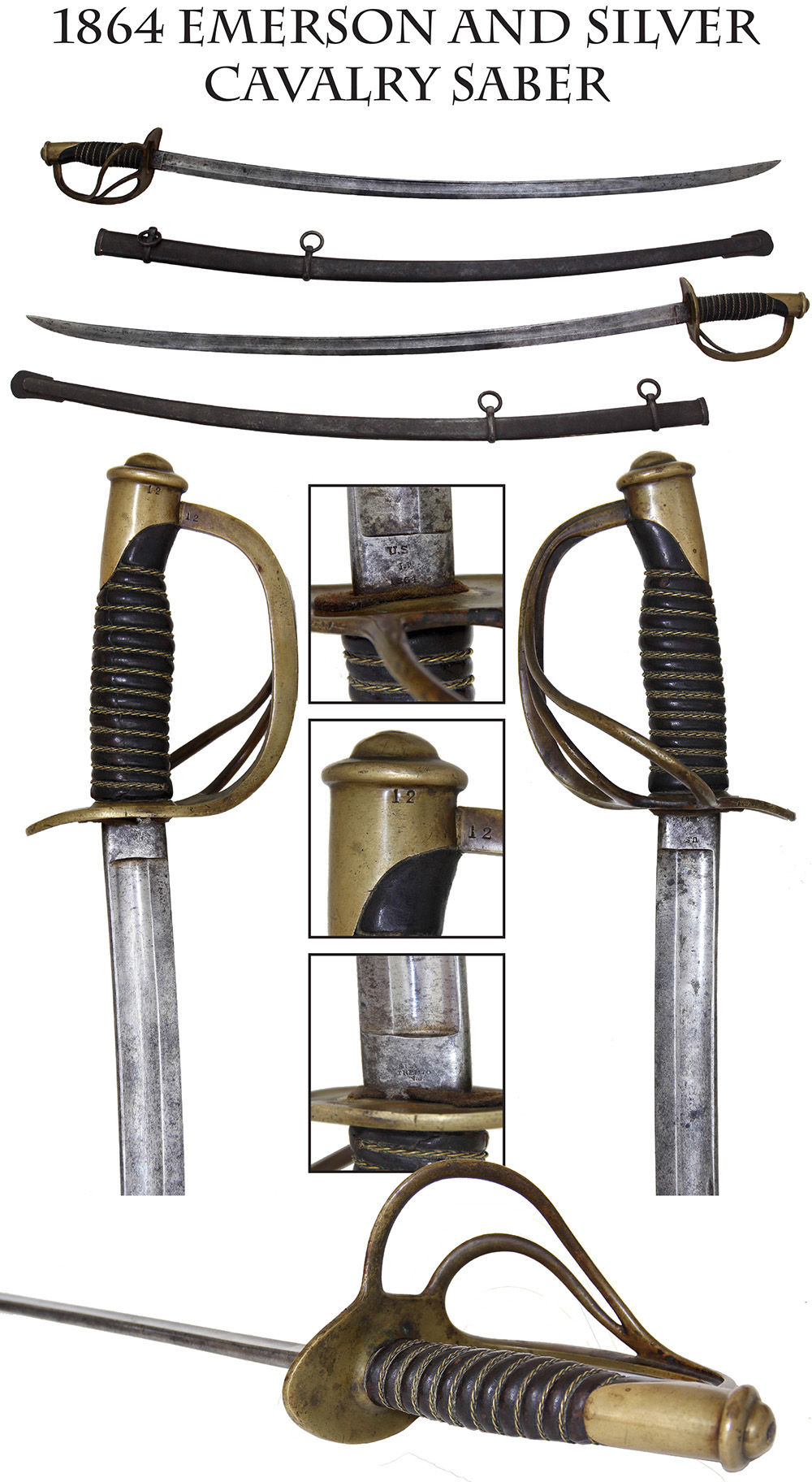
16-04-05 … 1864 DATED EMERSON AND SILVER MODEL 1860 LIGHT CAVALRY SABER WITH SUPER GRIP … The standard Union Army cavalryman’s saber. One of the most famous suppliers of edged weapons, Emerson and Silver worked out of Newark, N.J., making officer’s and enlisted cavalry and artillery sabers, NCO and musicians swords, etc. … with contracts to the Federal government and to the state of New Jersey. This is one of their Federal contract cavalry sabers, with a clear 1864 date, US acceptance and JM inspector’s mark on one side of the ricasso and “Trenton / N.J.” on the other, with the firm name lightly struck above it. The blade has a good point and edge, and shows a mix of dull silver with darker gray spots. Part of the leather pad at the shoulder is still there. The grip wrap and wire are outstanding. The brass shows a nice aged patina, with a rack number “12” on the guard and pommel cap. The scabbard is complete with rings, throat, and drag, showing gray mixed with brown, with no dings or dents. A very attractive example of the regulation Yankee trooper’s sidearm in much better condition than we generally see … dbe+abe=eej … $750.00 – SOLD
Call us @ 419-842-1863
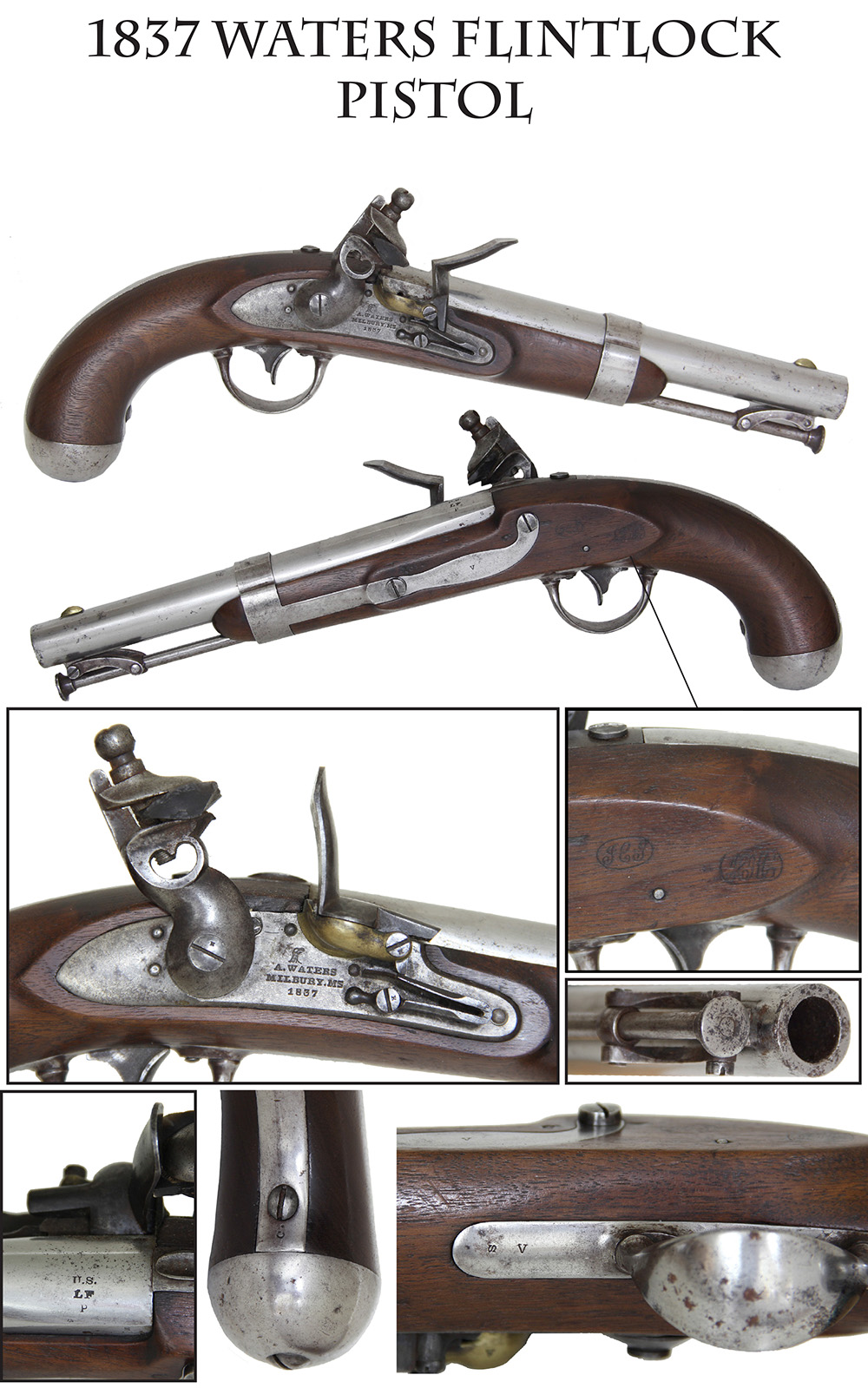
16-04-06 … TOP SHELF CONDITION 1837 DATED WATERS US MODEL 1836 FLINTLOCK PISTOL … Waters was one of two makers of this 1836 pattern of US cavalry pistol who supplied about 41,000 of them from 1836 to 1844. A very attractive, iron mounted pistol with swivel ramrod and brass pan, the 1836 was an improvement of the 1826 pattern and the last of the US martial flintlock pistols. It saw good service in the Mexican War and the early Indian Wars in the hands of US Dragoons, carried in pairs in saddle holsters over the pommel. Many made their way into state hands, were converted to percussion and even issued during the Civil War as reliable saddle pistols. Our example has excellent sharp edges to the wood and crisp markings on the lock and barrel. The metal is smooth and in the bright, with just some graying on the lock. Mechanically perfect. Nice untouched patina to the brass pan. Very visible and legible ink inspector cartouches in the wood. Sharp inspector and sub-inspector stamps. A couple of minor brown spots on the trigger guard and face of the muzzle. A very handsome US martial flintlock in a condition worth waiting for. NRA fine condition …
ck-17237 – tag2500 … $1,750.00 – SOLD
Call us @ 419-842-1863

16-04-07 … 1906 U.S. CAVALRY SABER … These steel hilted versions of the 1860 cavalry saber were introduced after the army expanded the number of cavalry regiments in 1901. Old stocks had been depleted and a number of experiments in sword design were tried to improve the design and meet the demand. By 1905 the army came back to the 1860 design with the scabbard rings placed closer together to change the carrying characteristics, and substitution of a steel guard for the 1860 brass. Ours bears the Ames Sword Company initials with the U.S. ordnance flaming bomb and 1906 date, all crisply stamped on one side of the ricasso and a “US” on the other. Good condition overall. The blade is bright, with a good edge and point. The hilt and scabbard still show some light cleaning. The wire binding is excellent. The leather is overall good though partially flaked just below the pommel cap. Scarcer than the Civil War sabers but more affordable … bjj-mil … $450.00 – SOLD
Call us @ 419-842-1863

16-04-08 … CIVIL WAR OFFICER’S SADDLE VALISE… Nicely embossed with a large star at each end reminiscent of U.S. dragoon usage, this leather saddle valise has a central opening flap that is secured by two straps and buckles and is fitted with a carrying handle as well. Nice, untouched black harness leather, now partially oxidized to brown. Solid condition. The two fastening straps have broken off near the edge of the closing flap and there are some scrapes and abrasions to the finish, but these can easily be restored. This is a great valise that would dress up an officer’s saddle immensely. See our image of a sketch by the famed Randy Steffen showing a U.S. dragoon officer circa 1847 and note the valise he has illustrated. A very scarce piece of horse equipment … 6 3/4″ diameter and 18″ long … djj… $475.00 – SOLD
Call us @ 419-842-1863
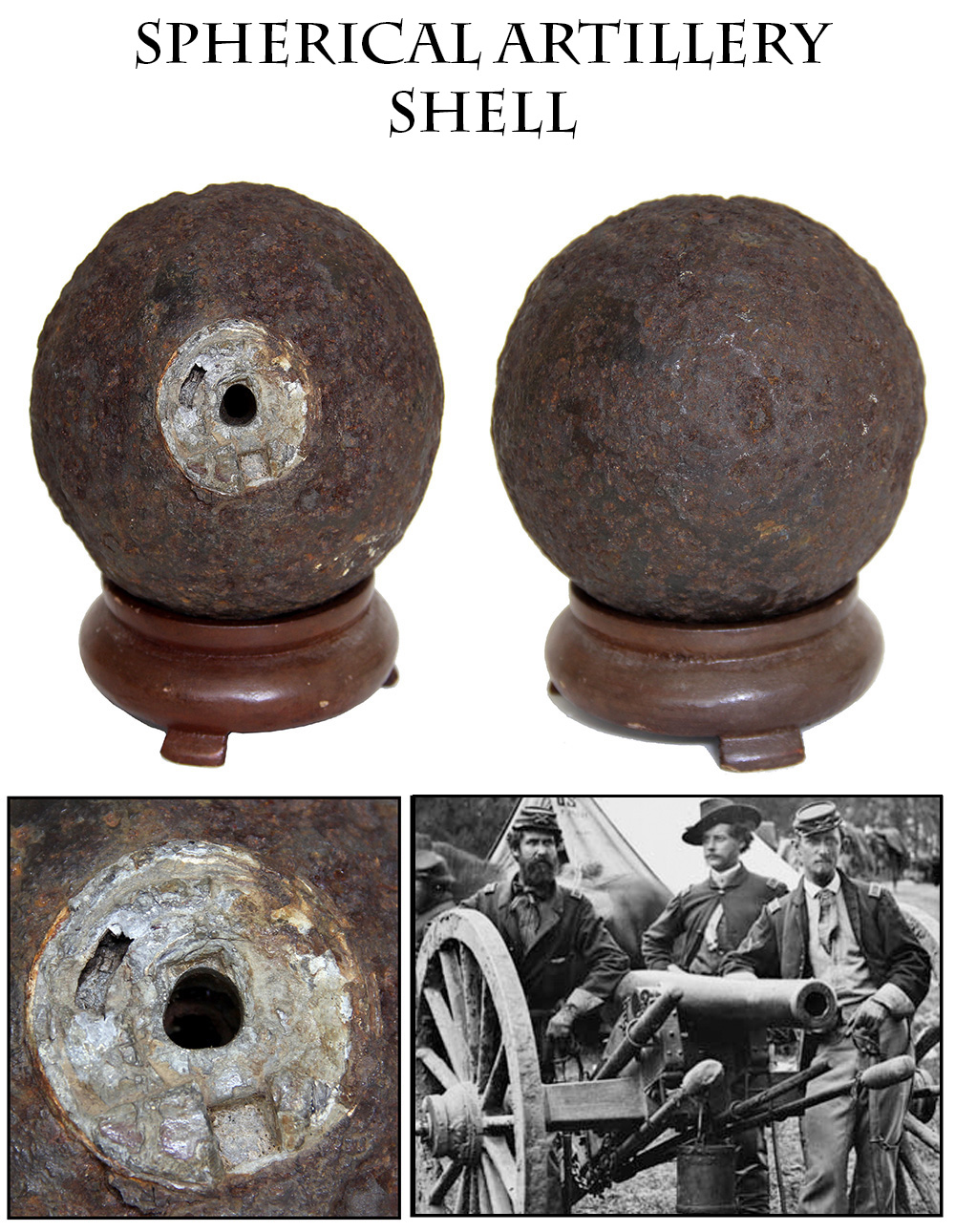
16-04-09 … TWELVE-POUNDER SHELL WITH BORMANN FUZE … This shell is heavily corroded but shows plainly the Bormann time fuze in place. Developed in the 1850s, the Bormann fuze allowed a gunner to pierce a thin metallic cover on the fuze and allow the main charge of the gun to ignite the fuze which was set to burn for a selected time along its journey. The gunner knew how fast the ball moved, and he knew the distance to the enemy. The timing feature allowed him to set the explosion of the shell directly over his target based on his prior calculations. The effect was horrific when timed precisely. I’m not sure if this is a shell or spherical case-shot, but it is inert and the fuze has been drilled out in the center. It makes a nice display piece on its wood stand … roughly 4″ diameter … jj-mil … $195.00 – SOLD
Call us @ 419-842-1863

16-04-10 … CONFEDERATE JS / ANCHOR LONDON ARMOURY KERR REVOLVER … A classic Confederate Kerr revolver. Confederate agents in England made early efforts to corner the market on Kerr revolvers and purchased some 9,000 of them in 54 bore, .44 caliber, from the London Armoury Company, most of them falling between serial numbers 1019 and 9975. Ours is numbered 3658 and thus falls pretty early in that range. This bears the Confederate view mark of “JS” over an anchor below the trigger guard tang. Muted silver gray overall. L.A.C. with view and proof markings in the left barrel flat. London Armoury Company oval stamp on lower left frame and “London Armoury” on right grip strap. “Kerr’s Patent 3658” on right lower frame and “3658” on cylinder. One-piece, checkered wood grip is tight to the metal and slightly warped due to a slight bend in the lock. Front sight, loading lever, cylinder pin, lanyard ring all in place. Mechanically gummy and does not hold on full cock, but we’re not going to shoot it anyway. All original except for a lock screw and grip screw which are proper replacements. This is the “3rd Variation” Kerr, that started around number 3,000 and continued to the end of production with number 11,500 around 1866. The differences being the use of a centered loading lever screw and the improved arbor pin latch. The use of just “London Armoury” without the “Co.” on the grip strap, however, is the earlier pattern marking and is thought to have been used intermittently from number 3,000 to number 6,000, with extant examples noted as high as number 4122. All of which gives it a very good chance of being made in 1863. There were far more Kerr revolvers in the hands of Confederate soldiers than any of the Confederate domestically made revolvers, and they were likely outnumbered only by Colts and Remingtons. A dead-real Johnny Reb cavalry revolver that will not break the bank … $3,950.00 – SOLD
Call us @ 419-842-1863
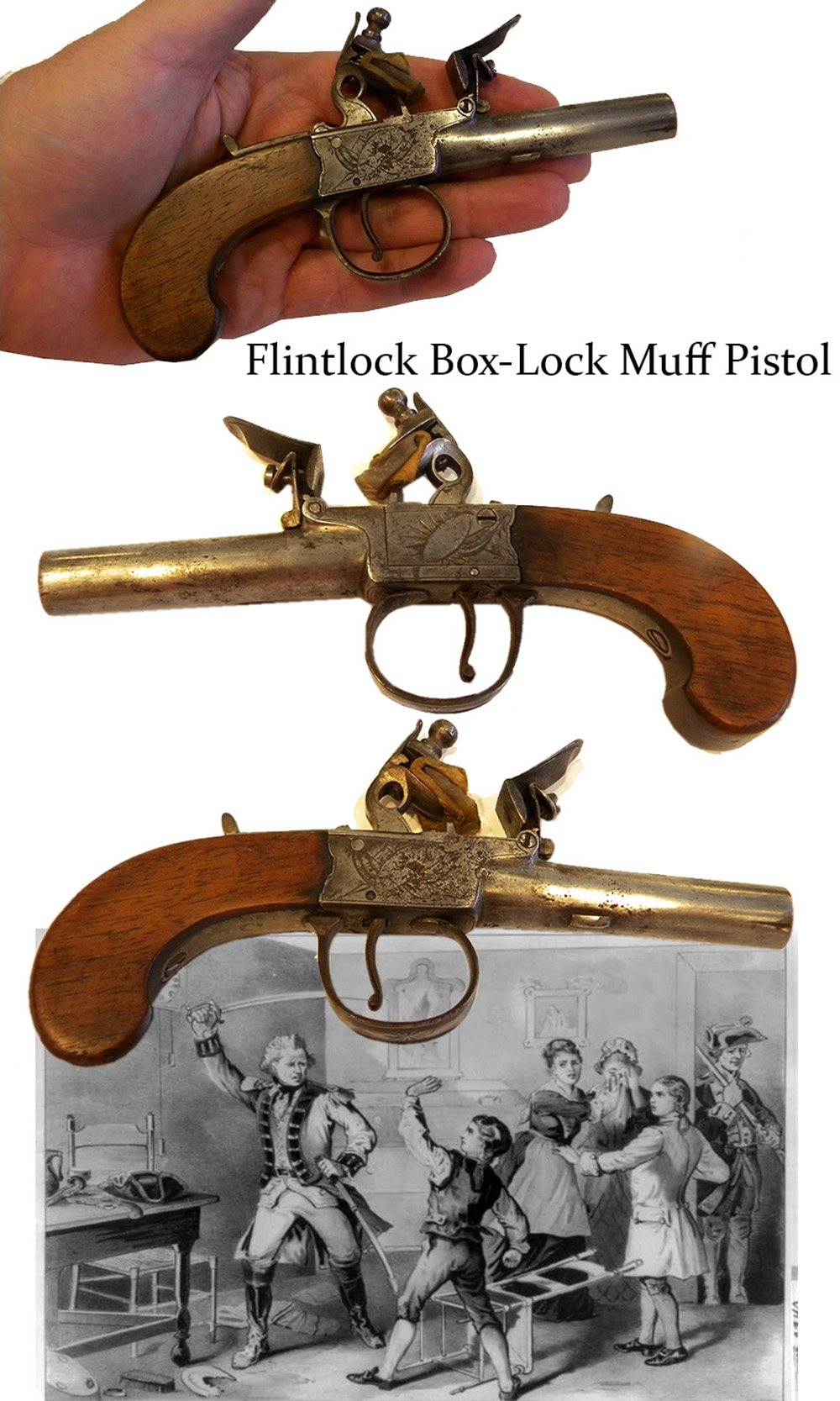
16-04-11 … ENGLISH FLINTLOCK MUFF PISTOL … A solid early weapon from the first quarter of the 19th century. Ca. 1820. Fits in the palm of my hand. Barrel is 3 inches in length. About 44 caliber. Overall VG to fine condition. 100% original, 100% complete, and mechanically perfect. Box lock design with sliding safety behind the hammer. The left and right sides of the frame are engraved with panoplies of arms. Unsigned by maker. A handsome early weapon now approaching 200 years in age.. 3 inch barrel 7 inches overall … $550.00 – SOLD
Call us @ 419-842-1863
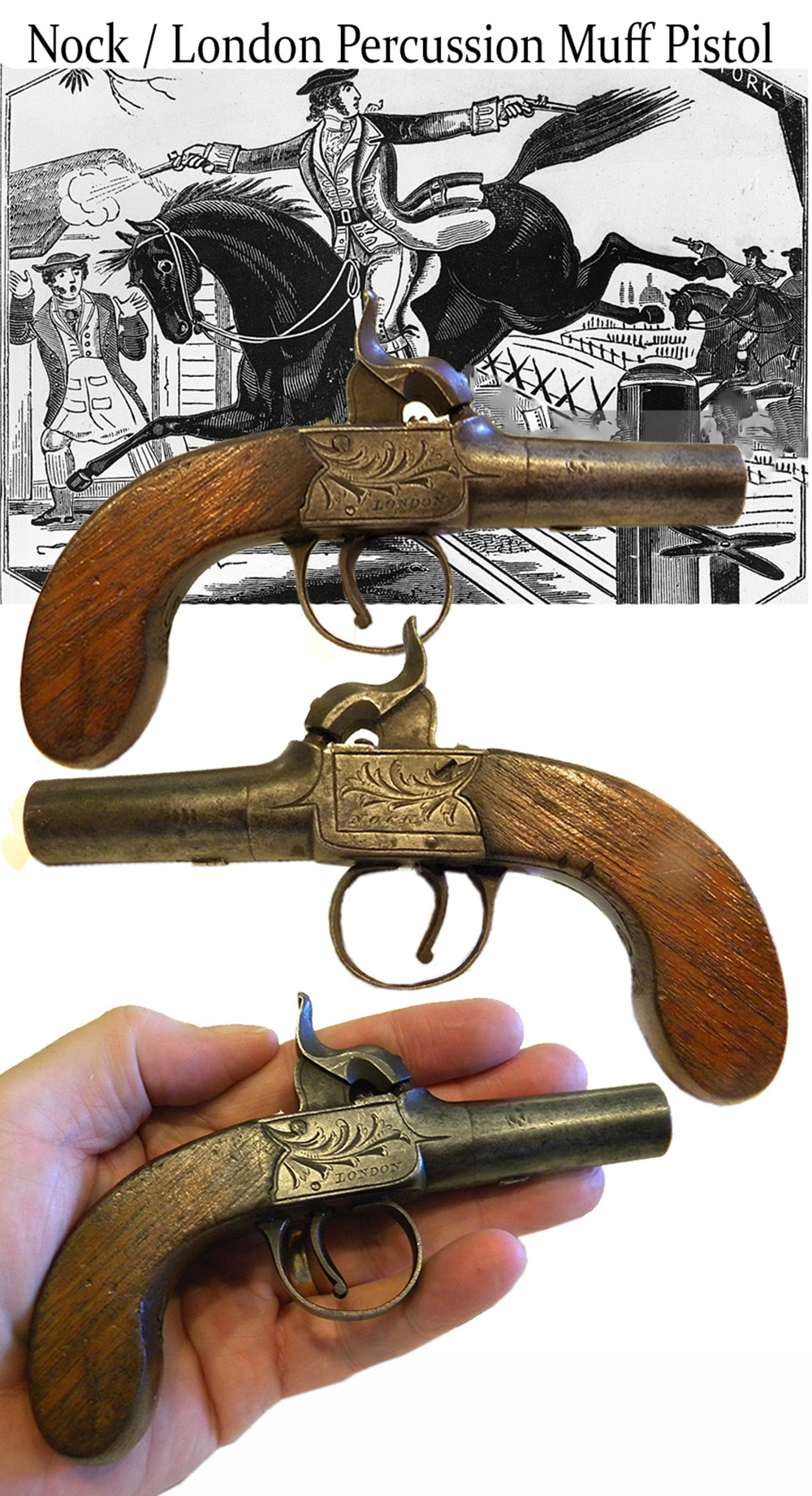
16-04-12 … ENGLISH NOCK SIGNED MUFF PISTOL … A handsome little weapon from the first half of the 19th century. Ca. 1835. Fits in the palm of my hand. Barrel is under 3 inches in length. About 44 caliber. Overall VG to fine condition. 100% original, 100% complete, and mechanically perfect. Box lock design. Signed NOCK on one side and LONDON on the other. This being Samuel Nock, nephew of famed Henry Nock. The left and right sides of the frame are engraved with leafy scrolls. A handsome early weapon now approaching 200 years of age.. 6 inches overall … $465.00 – SOLD
Call us @ 419-842-1863

16-04-13 … AMES MODEL 1833 DRAGOON SABER WITH 1839 DATE … – One of the scarcer American swords to find in nice condition is the ’33 Ames Dragoon Saber. These were used by US Dragoons (cavalry) during the time of the Battle of the Alamo, The Seminole Indian Wars, The Mexican War, Service on The Western Frontier and Texas, and of course The Civil War. This is a very representative example with inspector’s marks on the drag, and good blade markings including “United States” and the full Ames firm marking and date of 1839. The blade is gun metal grey with some age staining. The scabbard has one crease about 8 inches from the drag. The scabbard also has a nice brown patina and a little crustiness, It has traces of original lacquer brown finish. The grip leather and twisted wire wrap are 100% original and intact and in very good condition. A very good example of a very scarce sword … cjj+bde-jpal … … $1,250.00 – SOLD
Call us @ 419-842-1863
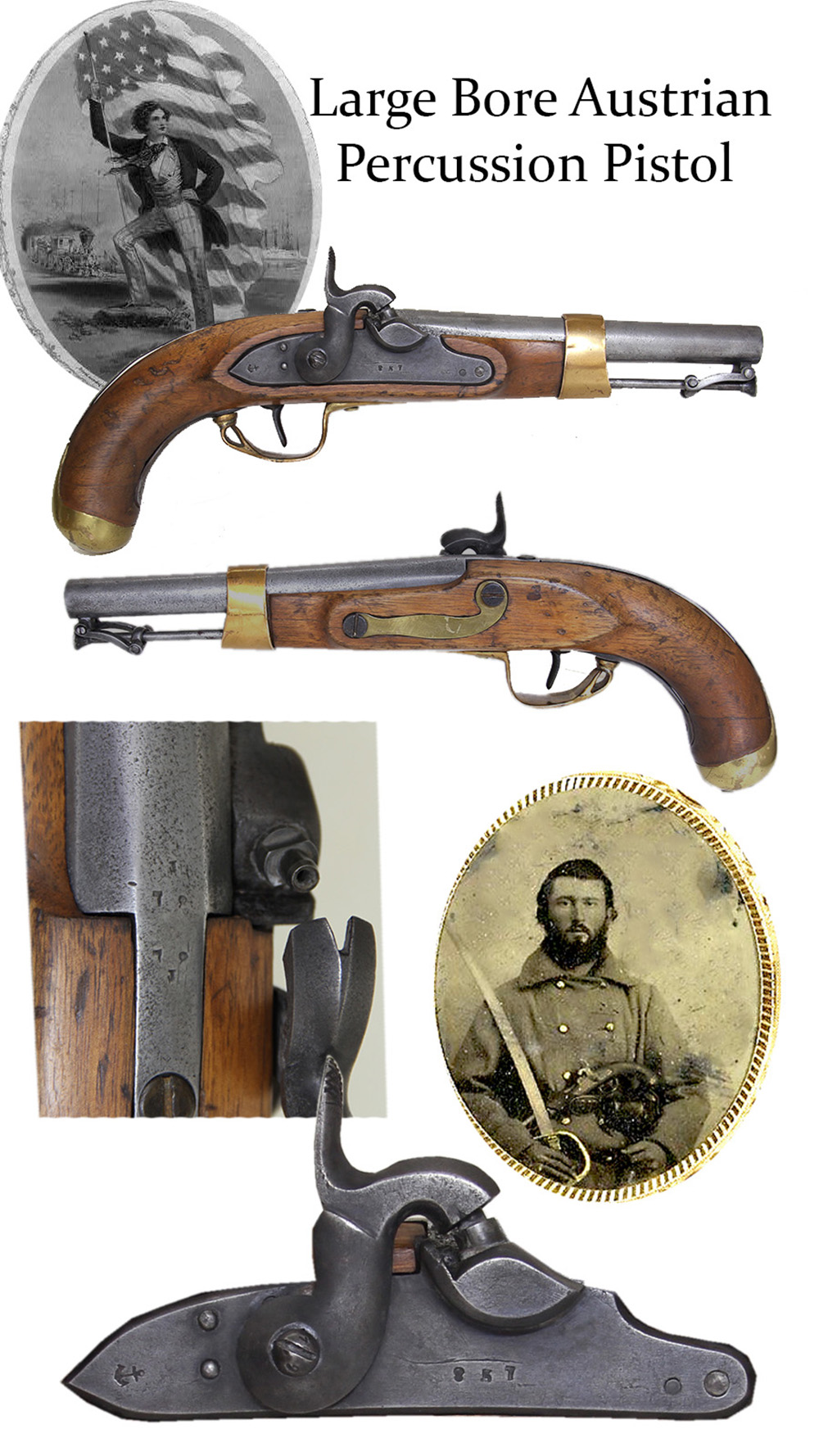
16-04-14 … LARGE BORE AUSTRIAN MARTIAL PISTOL … Roughly 72 caliber, this jumbo horse pistol is very similar to our US Model 1842 pistol but does not show near the quality of a US made gun. The lock is marked 857 which represents a manufacture date of 1857. The anchor behind the hammer may indicate navy use, but the gun is a cavalry pattern and void of any belt hook which is usually present on 19th Century European naval pistols. I personally doubt the anchor represents navy issue. I will let you research further to uncover the meaning of the anchor. Overall about VG condition. Has the original captured ramrod. Mechanically good though only holds on half cock. Full cock does not hold. I’ll let you mess with filing the sear. All original and complete except tang screw is an old replacement and the S shaped escutcheon is replaced. Trigger guard has a lanyard loop at the rear. The soldier would loop a cord of leather around his wrist and tie it through the brass loop on the back of the trigger guard so that the pistol would not fall to the ground should he drop it, or have it knocked from his hand. A big old Yosemite Sam style pistol priced friendly … zxbejll…. $465.00 – SOLD
Call us @ 419-842-1863
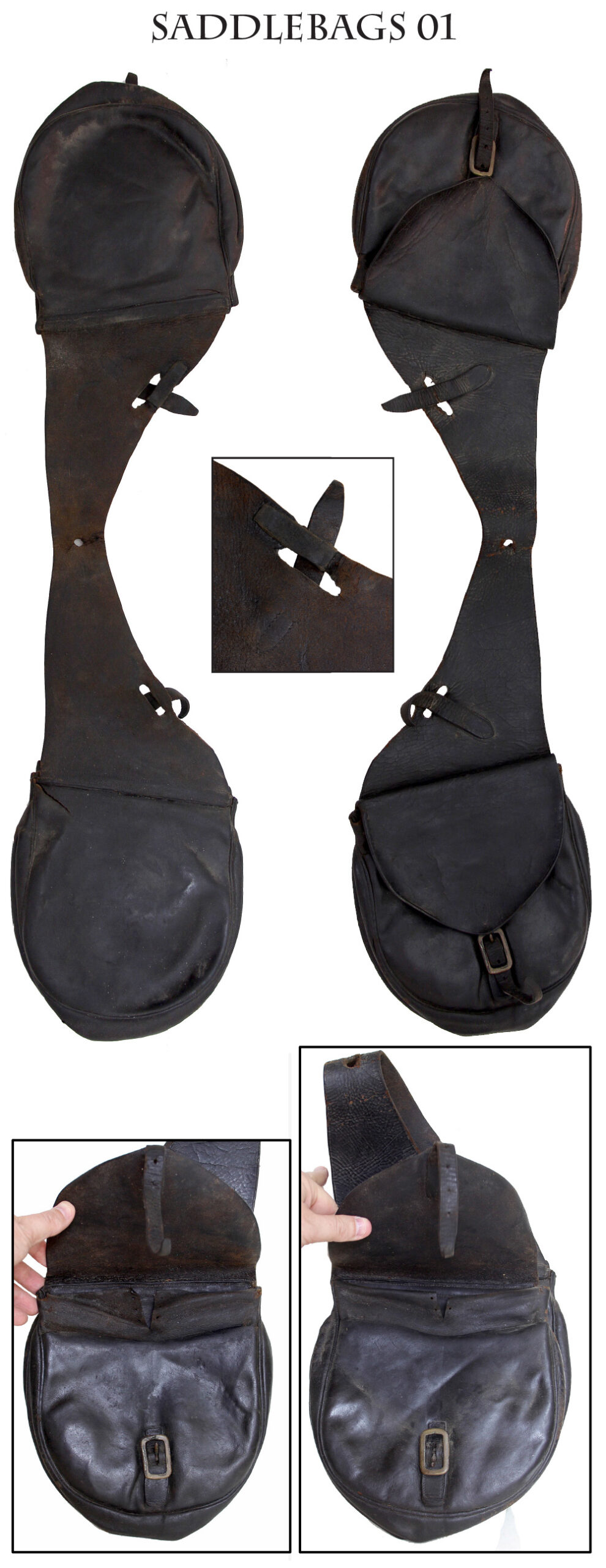
16-04-15 … 1859 McClellan Pattern Cavalry Saddle Bags … Regulation issue cavalry saddlebags for the standard US cavalry enlistedman’s saddle of the Civil War, the 1859 McClellan. Both bags and covers in good shape. A very scarce piece of Civil War equipment. The covers are slightly stiff. Both latch tabs and buckles are in place. Interestingly this set was made without the bottom tie-down straps. These straps are usually found removed by the trooper (see other set of bags below for further data) but this set was manufactured without them. Perhaps a mid war directive that I am unaware of called for the elimination of the straps. Interior pockets good. As usual the leather laces on the inside are gone but can be replaced with any old rawhide boot laces. One small repair to the edge of the cross strap at the hole where one of the locking straps for a bracket passes over it. The cross strap itself is solid and in good condition, which is rare since people often try to fold these flat and break the straps across the middle. A very good displayable set and a key piece of horse gear and one that has always been scarce … noco … $1,250.00
Call us @ 419-842-1863
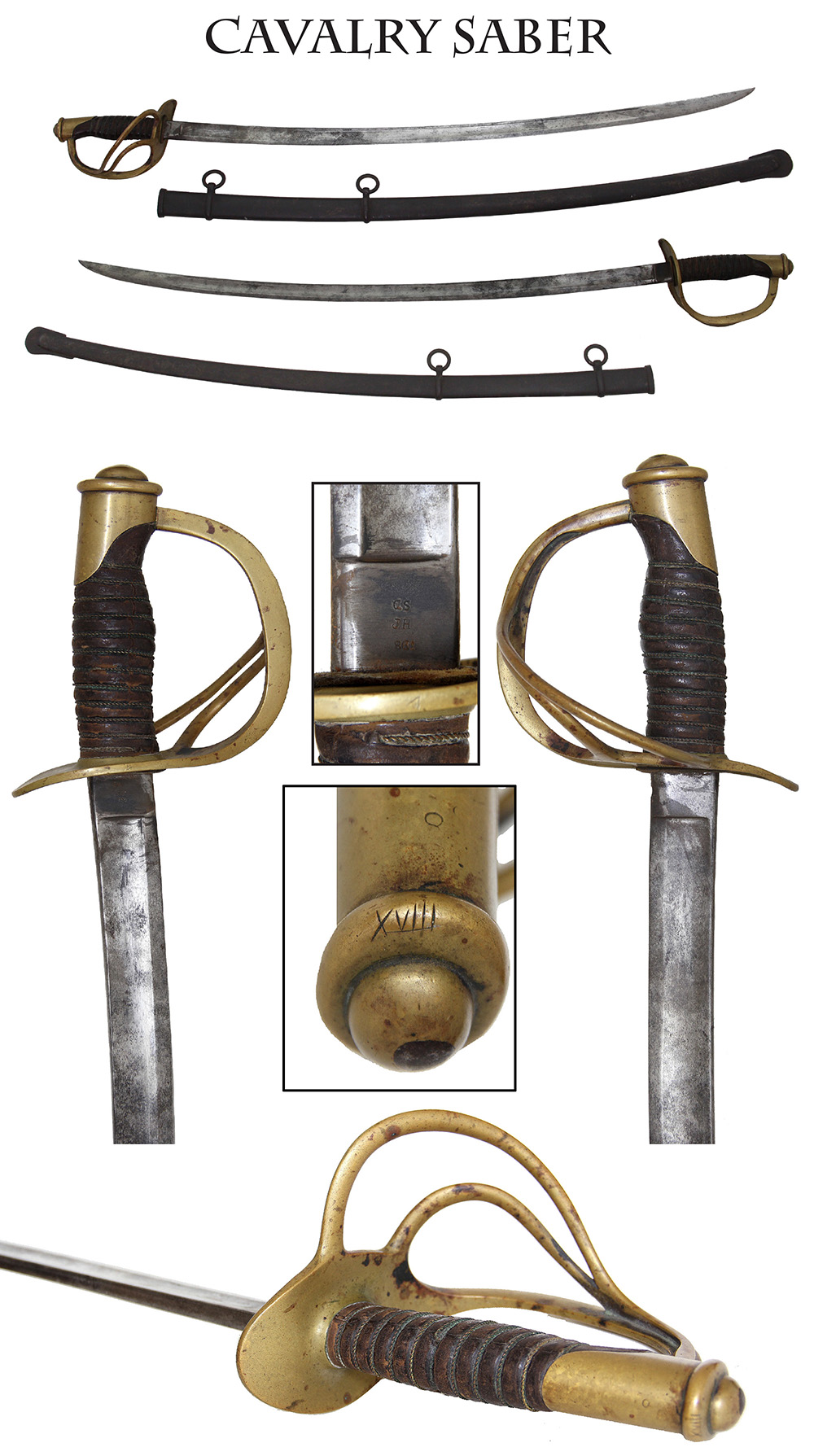
16-04-16 … CAVALRY SABER LIKELY CONFEDERATE USED 1861 DATE … Here’s one for the books… 1861 dated US 1860 pattern light cavalry saber. Probably an Ames product, but with no maker’s name and address on the ricasso. The opposite has a clear “JH” inspector’s stamp and the last three digits of 1861 visible. The “US” stamp above the JH has been altered to a “CS”, and not done recently. Who did this is anyone’s guess, but thousands of Ames sabers were definitely sent south just before the war. I’m guessing that someone in a Confederate armory actually changed the U to a C out of some sense of indignation at seeing the northern motto… but I certainly can’t prove it. This does have a crude Roman numeral “XVIII” cut in the pommel cap, a typically Confederate way of bench marking swords and scabbards, but seemingly unnecessary on an Ames product that has not been repaired. The presence of the US inspector’s initials “JH” would tend to indicate acceptance by the US, unless “JH” was working at the Ames factory and Ames pulled the saber for shipment to Virginia in early 1861. There are no inspector’s initials on the drag. Full original grip leather and wire are VG++. The pad is present at blade shoulder. Mixed light gray blade with silver showing through, good edge and point. Scabbard an even brown. Medium tone to the brass. An interesting 1860 cavalry saber that really gives you cause to ponder a southern association. In any event darn rare with the 1861 date, and I’m not charging extra for my speculations … gjj … $895.00 – SOLD
Call us @ 419-842-1863
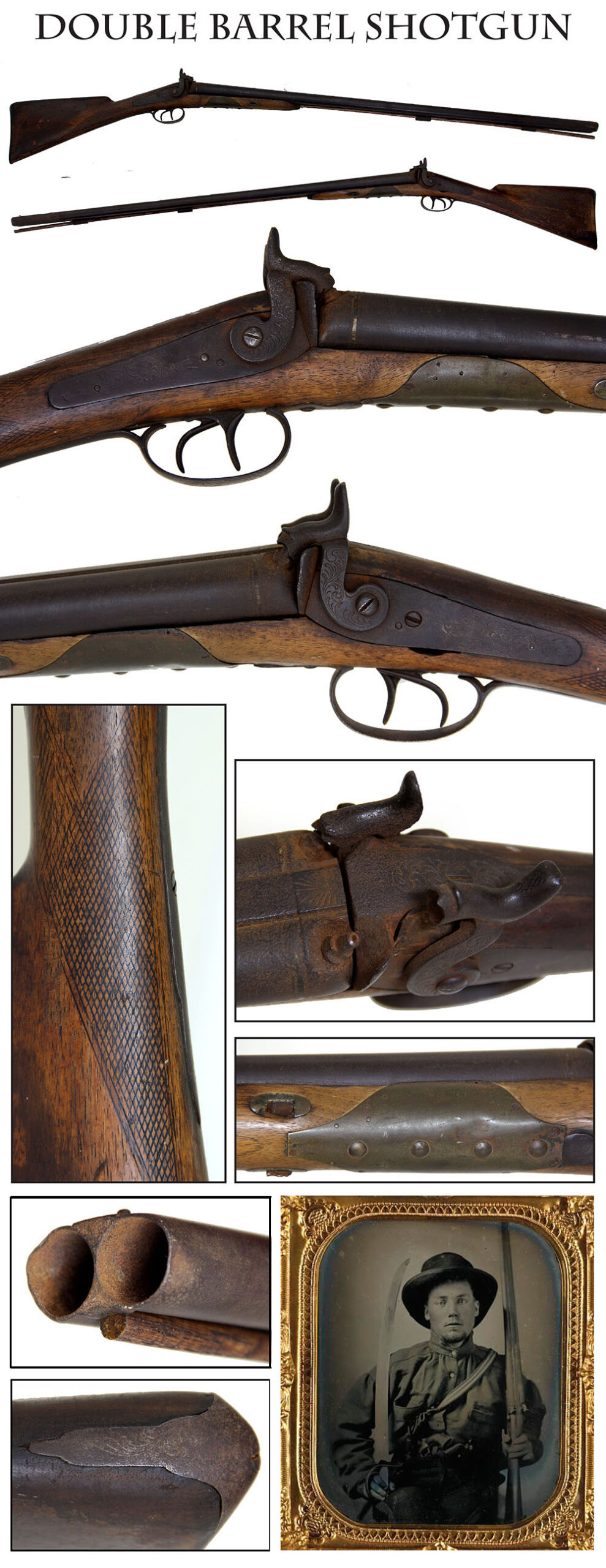
16-04-17 … DOUBLE BARREL SHOTGUN … Percussion double barrel shotgun just like the one the reb shown above is shouldering. Back action lock with standard double triggers. A very plain no-nonsense gun with some minimal engraved decoration on the iron buttplate, breech, and lock, along with some shallow checkering on the wrist. This shows a classic frontier gunsmith repair. It has a brass hand plate tacked and screwed to the short forestock, which serves to secure a crack (now invisible and hidden). This handsome repair is unquestionably from its period of use, the brass having a superb age patina. The barrels are 24 inches long. Bore is 12 gauge. It has a crude, wood ramrod (newer) retained by two thimbles. A low front bead is still present. These shotguns were pressed into use early in the war, particularly by southern mounted troops. They lacked range, of course, but had the advantage of hitting something even if fired by a man jostled about on horseback. A shotgun is the ideal weapon for close quarters fighting on horseback. In addition, as affordable simple guns that could put food on the table, they were probably more responsible for the westward expansion of the country than the more glamorous Winchesters and Colts. Brown metal overall, with some corrosion to the hammers. Decent wood with a small chip below the left lock. Left hammer cocks and functions. Right hammer does not hold on full or half cock. Our man Steve says his first percussion longarm was one of these, given to him by his grandfather. I tried to talk him into buying this one but he feigned temporary deafness. I think he felt guilty recalling how he sold Grandads gun and can’t now recall what he spent the money on … or who. A perfect gun to display with Confederate cavalry effects at an entirely livable price … $235.00 – SOLD
Call us @ 419-842-1863
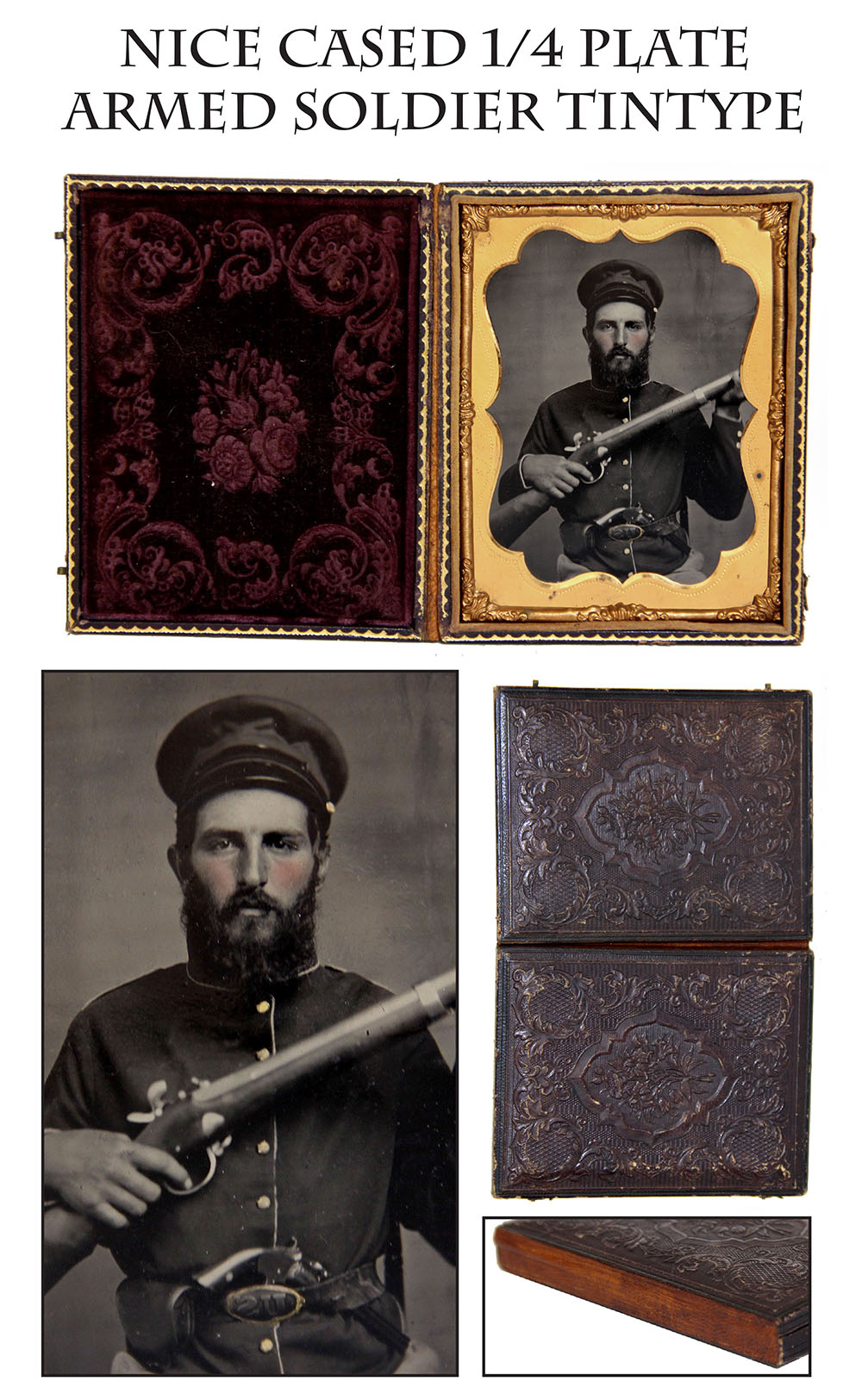
16-04-18 … EXCEPTIONAL CASED ¼ PLATE DOUBLE ARMED SOLDIER TINTYPE … An early war volunteer off to save the Union wearing a state jacket and early Mexican War style “wheel” cap. Our man has tilted his cap back slightly to avoid casting any shadow. His jacket is reminiscent of the New York 1861 volunteer jackets, but the buttons are smaller and there is piping down the front. He wears an oval US plate and cap box on his waistbelt, and holds a cocked percussion musket up for the camera that appears to be one of the early war, ungainly European imports. For added measure, he has tucked a Smith and Wesson Number 2 Army revolver in his belt. The image has great clarity and tone. The photographer delicately tinted our man’s cheeks and put just a touch of gilding on the buttons and edge of the belt plate. This comes in its original leatherette case with embossed floral designs. The hinge has been repaired, but the case is solid. A top shelf image with everything going for it. Large size, superb clarity and contrast, an unusual uniform, and two firearms. Darn fine! … bzky … $795.00 – SOLD
Call us @ 419-842-1863
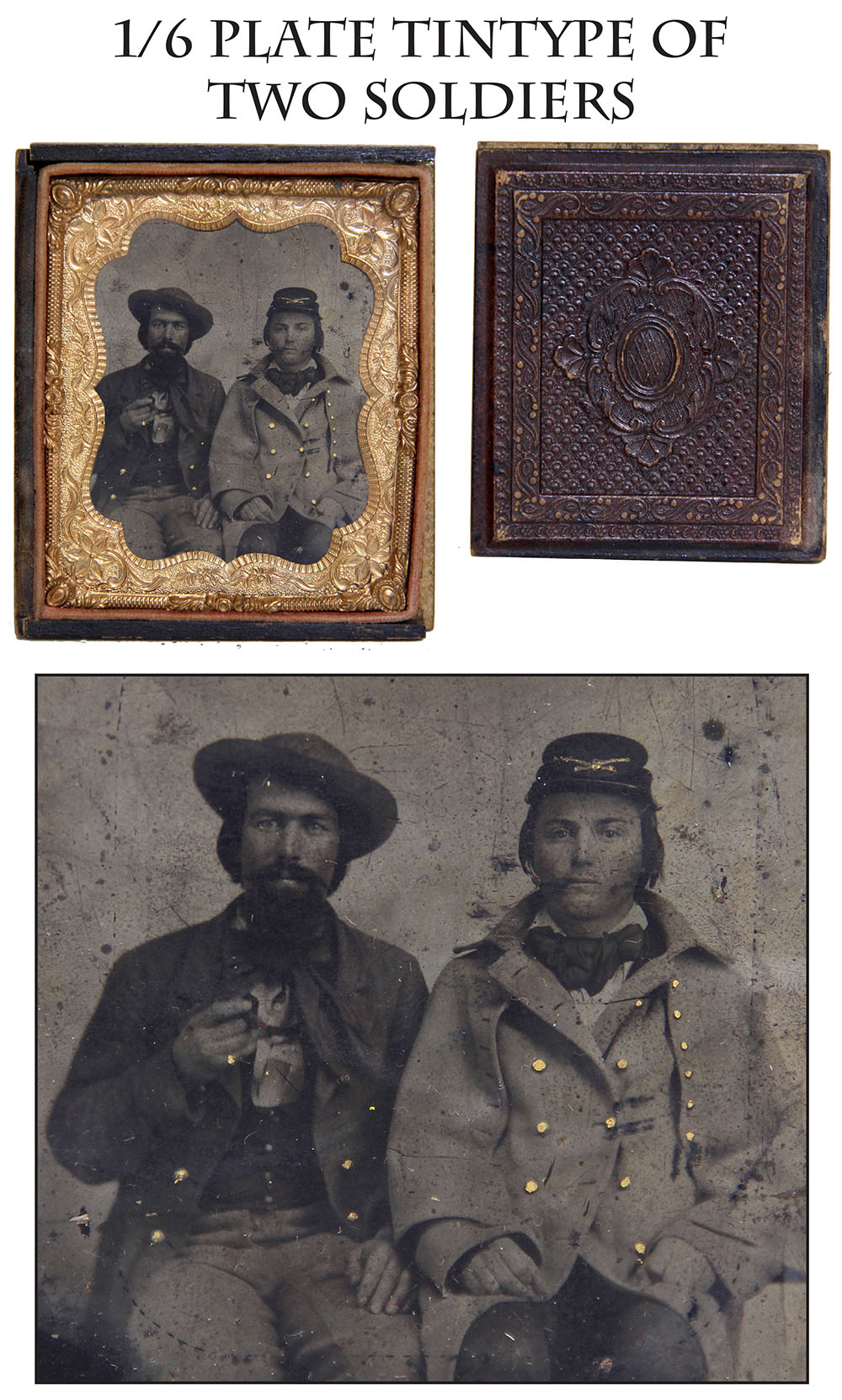
16-04-19 … 1/6 PLATE TINTYPE OF TWO TOUGH LOOKING, TOBACCO SMOKING PARDS … Two pards share a smoke. The soldier on the right wears a forage cap with the crossed sabers of a cavalryman on top and a double-breasted regulation mounted overcoat with its long cape. He has a cigar in the corner of his mouth, angling out toward his friend… though the camera angle does not show it well. Note the photographer put a tiny dab of red/orange paint on the end of the cheroot to imitate the glow of the burning tobacco. His pard on the other hand has lowered his cigar slightly and holds it chest high for the camera. He could be a civilian friend of the soldier, or his friendly sutler and tobacco supplier, but the photographer has gilded his buttons just as he has on his companion’s overcoat indicating that he too may be a soldier. In any case, they have gotten together to have a friendly smoke and immortalize the occasion with a visit to the local photographic artist. Some scattered spotting and rubs to the plate, but nothing distracting and these guys have something of a hypnotic stare going which adds greatly to the appeal and mystery of the image. Both sport the longer hair generally associated with men in the western theater or on the frontier … ge-16025 … $225.00
Call us @ 419-842-1863
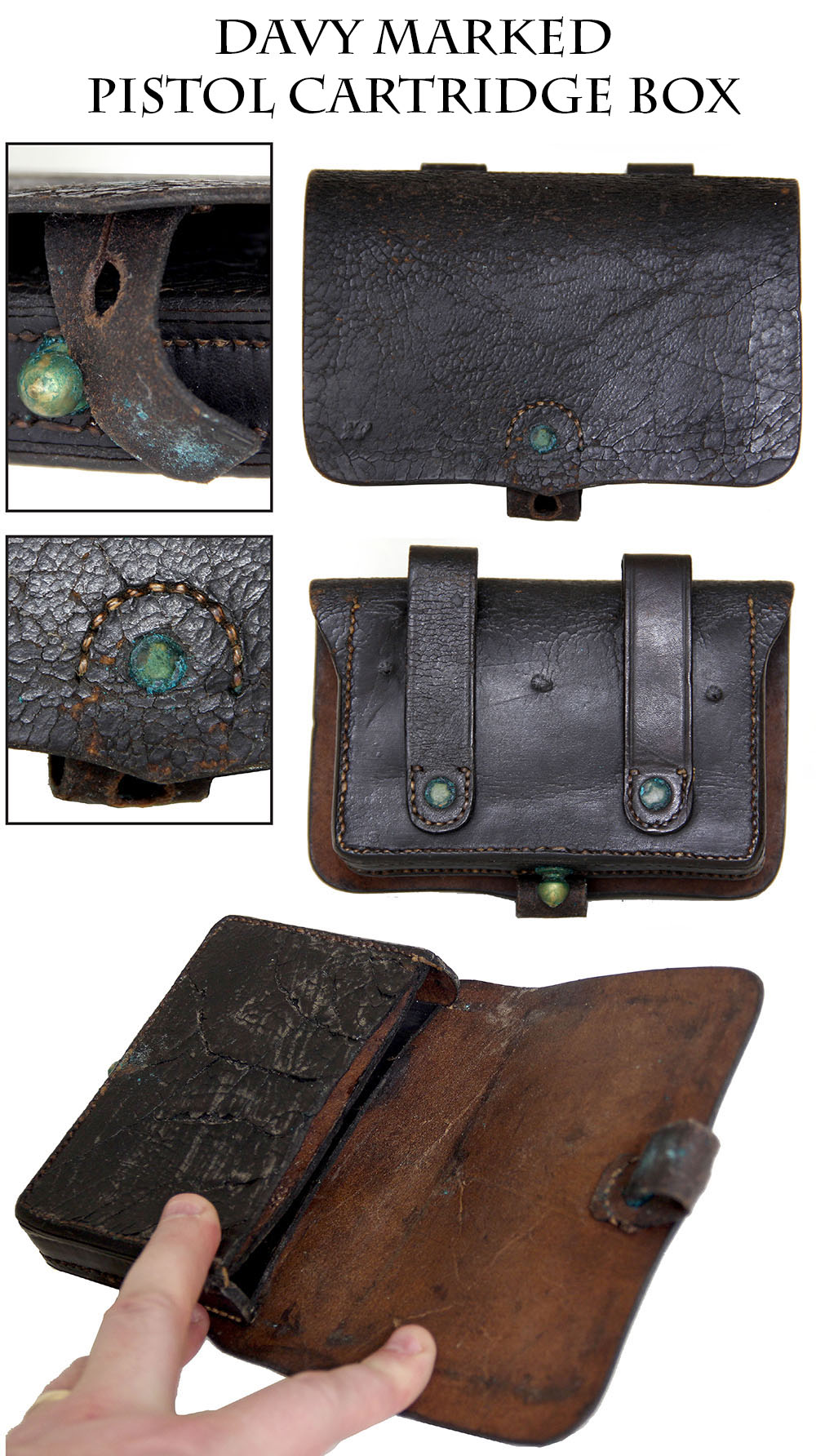
16-04-20 … DAVY MARKED PISTOL CARTRIDGE BOX … Cavalrymen were issued their pistol cartridges in packs of six. The pistol cartridge box has two inner leather pieces to hold the packs in place by friction until the soldier needs to take one out and reload. The same pouch could hold either .36 or .44 caliber packs, but the size changed during the war to accommodate changes in the packs themselves. This is a nice mid-war example, being the medium size but using both stitching and a rivet to secure the latch tab. Belt loops are solid and intact as is the latch tab. Cover shows lots crazing, but is not stiff. “J. Davy” maker’s mark is visible at lower center of front indicating manufacture by Joseph Davy and Company of Newark, NJ, who had large federal contracts for leather gear. The asterisk marks on the leather are “stake marks,” created when Davy’s leather workers closed up the tack holes created by nailing the leather to wooden forms while sewing them together. A key piece of cavalry gear, and still affordable after all these years. (When I was in high school Turner Kirkland of Dixie Gun Works had crates of these things. He catalogued them at $4 and $5 each in the 1970s!) This is priced below most other CW dealers … ajj … $195.00
Call us @ 419-842-1863
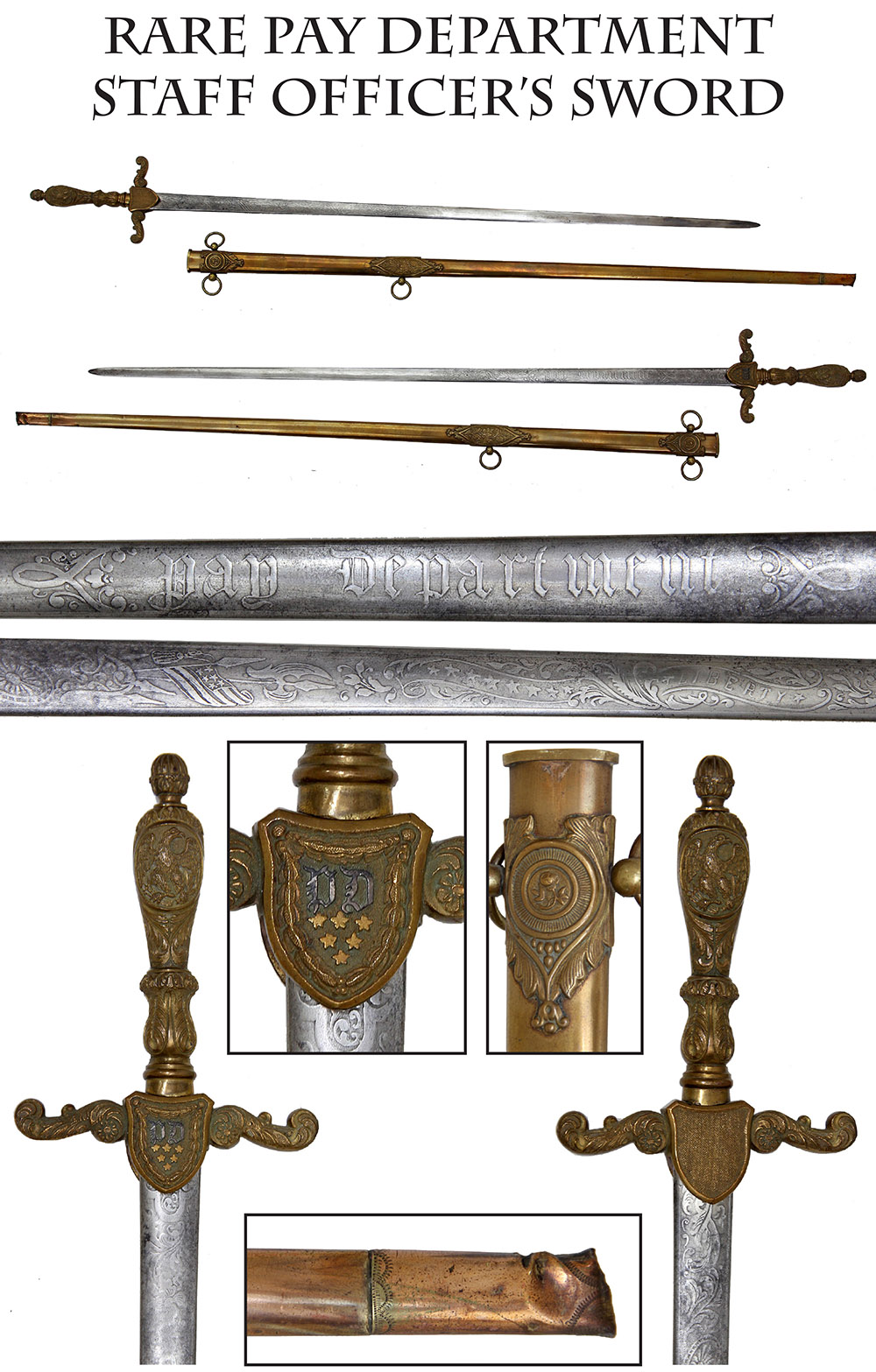
16-04-21 … EXCEPTIONALLY RARE PAY DEPARTMENT STAFF OFFICER’S SWORD … One of the holy grails for American sword collectors is the Model 1840 Pay Department Officer’s Sword. The scarcity due to the department being very small. Thillmann notes that they are very scarce: he examined only four for his book, all of them by Ames. He states, “it is believed other cutlers made Pay Department swords.” Well, here is one! This sword is the regulation pattern: nearly identical to the 1840 Medical Staff sword, but with “PD” in Old English letters in silver on the shield shaped obverse langet, set over stars and surrounded by a wreath. Retains the correct pineapple finial on top, with an eagle cast into an oval panel on each side. Several things set it apart from the Ames examples (other than having no Ames mark on it.) The panel holding the eagle is round rather than the elongated oval of the Ames castings, details of the grip casting differ slightly, and it has a taller ferrule at the grip base. The closest parallels I find are the grips on the Horstmann and Tiffany medical staff swords shown by Thillman. Other differences include the blade etching pattern and the use of “Pay Department” rather than “U.S. Pay Department” on the etched blade panel. The sword is certainly an import sold by one of the US military goods retailers. It is interesting to note that on the upper mount, rather than a star, is what looks like an acorn and leaves. Thillmann shows a Klingenthal made medical staff sword with flower design in this position. The acorn and leaves look a lot like a US navy insignia. The blade etching on this example is very visible, showing a dull silver against a grayish background. The etching pattern is a typical mixture of floral motifs and trophies of arms. But, on one side a US flag emerges from the cluster of spears and a ribband extends on either side of a floral scroll, with stars on one side and the word “LIBERTY” on the other. The scabbard is the regulation gilt brass with a double ring top mount. The tip of the scabbard shows an old repair. The heavily cast original drag was lost or damaged and was replaced with matching piece of brass, apparently from another scabbard, since it shows some light engraving. A very scarce sword that you will not likely encounter again in the near future … abej … $1,950.00
Call us @ 419-842-1863
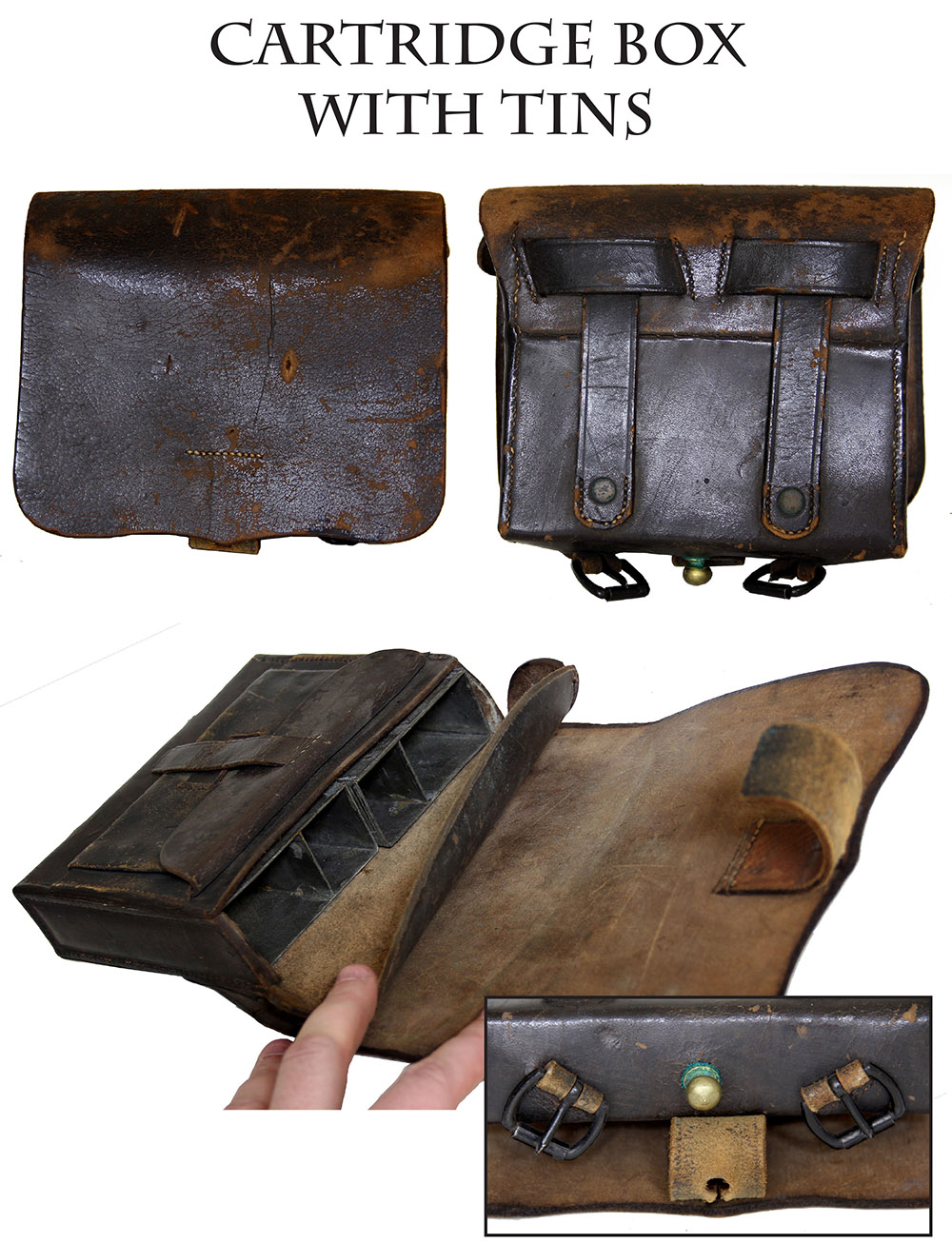
16-04-22 … 1861 PATTERN US CARTRIDGE BOX WITH TINS FOR THE .58 CALIBER 1861 SPRINGFIELD RIFLE MUSKET … Very good condition, early war, 1861 pattern cartridge box, characterized by the use of rivets at the bottom of the belt loops and a straight line of stitching with no rivet to retain the latch tab. Complete with shoulder sling buckles and latch tab in place, belt and sling loops present, implement pouch, cover and tab in place, and the two tin magazines inside as well – both having their upper dividers present, too. This one has lots of original finish left, just some loss along the top edges from abrasion and flexing in opening the box. The belt loops show a slight bit of stress, showing it was on a sling at one point and it’s pierced for a box plate, also indicating it was actually issued. This was well cared for and would make a great companion piece for that ’61 musket or early war display. Much better condition than most we see at the shows … cbex-wast … $425.00 – SOLD
Call us @ 419-842-1863
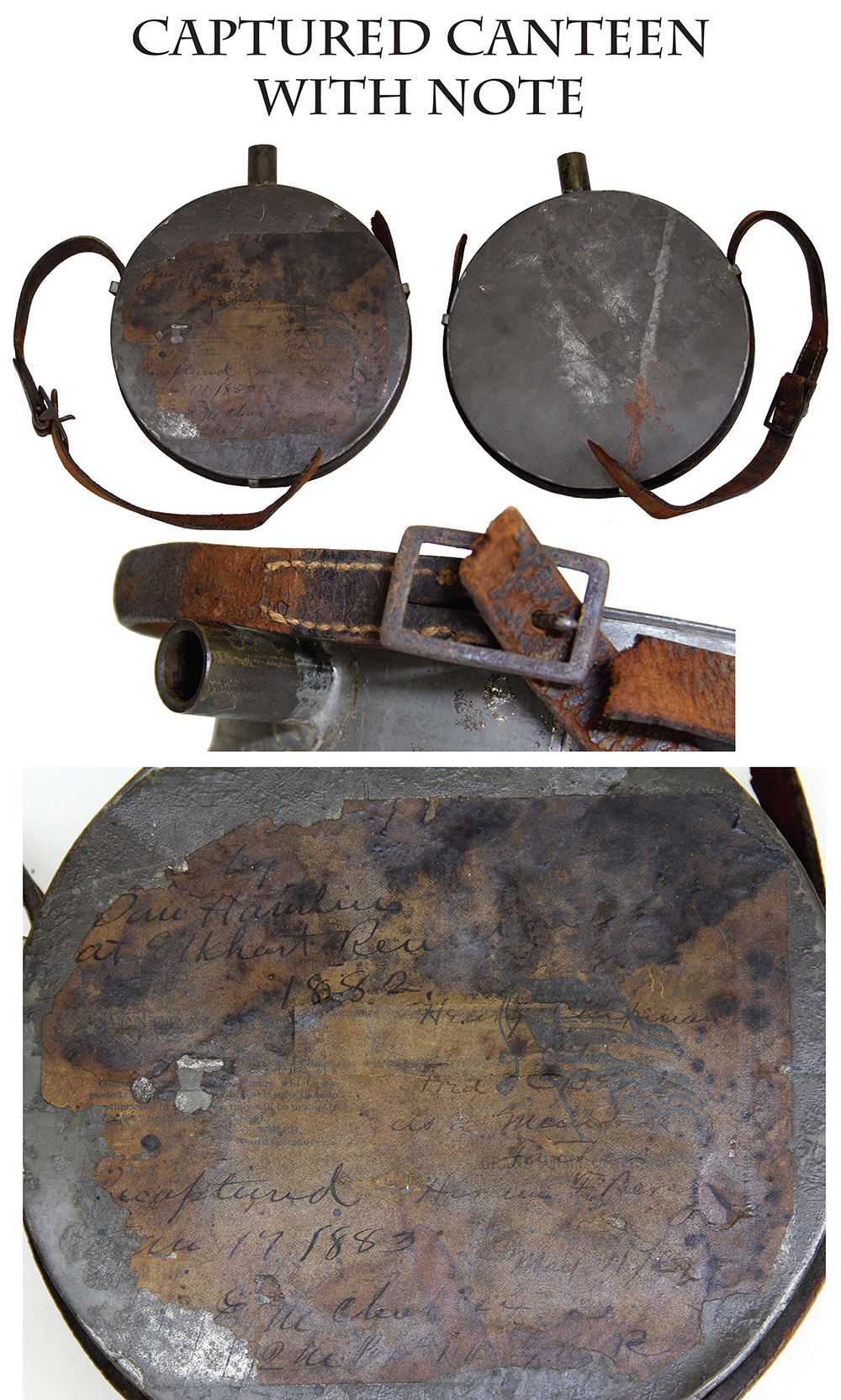
16-04-23 … SUPERB TAGGED CONFEDERATE TIN DRUM CANTEEN W/ STRAP Donated to a Warsaw, Indiana, G.A.R. Post by the Son of Lt. Hiram F. Berst, 6th Iowa Cavalry, as a Memento of his Father … Superb Confederate tin drum style canteen measuring a fine large eight inches in diameter with tall tin spout, three strap brackets, and an original carrying strap improvised from saddle blanket roll strap, broken now but still retaining its buckle. Wonderful GAR label glued on one side bears a period ink inscription on the right hand side reading “Donated to / Henry Chipman [Post] / by / Fred C. Ber[st] / as a memento of [my or his] / father / Hiram F. Ber[st] / May 11/87” The Henry Chipman Post was formed in 1886 by a breakaway group from the first GAR post in Warsaw, the Kosciusko Post, and the two remained separate until 1916. The label, in fact, is a piece of stationery from the earlier post: the name “Kosciusko” is visible on a cartouche on the US flag printed on the document, and a set of “General Orders” is also printed thereon and dated 1882, the year that post was founded. The orders are signed “N.C. Welch,” who is Nate C. Welch, that post’s first commander. The flag, and orders are deeply faded and stained but can be seen.
Our History Detective (historian Steve Rogers of Ithaca NY), is the best. He researched exhaustively and conclusively established the names of all the people mentioned on the tag. Hiram F. Berst (the man whose memory is being honored by the presentation of the canteen) lived in Kosciusko County, Iowa both before the war (he’s in their 1860 census) and after the war (he’s in their 1879 list of veterans). He had a son Frederick C., born in 1858 (the donor of the canteen in 1887). The elder Berst was in Marion, Iowa, when he enlisted at age 33 as a Second Lieutenant in Co. K 6th Iowa Cavalry. His commission dates to the same day and he served with the regiment until muster out 10/17/65 at Sioux City. The regiment served on the frontier fighting the Sioux. His company at one point garrisoned Fort Randall, Dakota Territory, and he mentioned as a Post Quartermaster at Fort Buford. The story on the tag suggests that the canteen was originally captured by Dan Chapin of the 12th and 138th Indiana. It further seems to contain a private joke about being captured and recaptured by GAR comrades in the twenty years since the war. Noting that there were two GAR posts involved in the ownership of this relic, therein likely lies the story of the “recapture joke”. The precise wartime and postwar history of the canteen hinges on a missing word in the inscription on the upper left side of the label. The bottom inscription is clear: “”Recaptured [J]une (?) 17 1883 /E.M. Chaplin/Q.M. Post 114 G.A.R.” Post 114 was the Kosciusko Post, and Chaplin was one of the founding members, having served in the 7th Indiana Cavalry for two years and mustering out as a corporal. The canteen obviously made its way into his hands after being lost earlier.
The key is the missing word of the upper part of the inscription, which reads: “… by / Dan Hamlin /at Elkhart Reunion /1882.” If Hamlin, who served in the 12th and the 138th Indiana Infantry, “captured” the canteen at the Elkhart reunion, then it might have belonged to Berst, whose son later donated it to the other post after Chaplin retrieved it. If, on the other hand, the canteen was “lost” by Hamlin (and later recovered by Chaplin in either case), then it may have belonged to Hamlin in the first place and simply made its way into Berst’s hands over the years through Chaplin. Berst was active in raising funds for the reunion of another county regiment in 1886, so he seems to have been an active GAR man in general. In any case, when the Kosciusko Post split in 1886, Chaplin defected, to become the first commander of the Chipman Post, and it seems Berst went with him, since his son later gave the canteen to that post. In any case, if the canteen was brought back by Hamlin the Hoosier, he could have obtained it during his service as a private with the 12th Indiana from 5/7/61 to 5/19/62, or in the 138th as Captain from 5/18/64 to 9/30/64. The latter regiment served for a hundred days doing railroad guard duty in the Nashville area, keeping Sherman’s lines of communication open. The former regiment was a one-year outfit that served in Banks’ Army of the Shenandoah, doing “picket and outpost duty by companies, with frequent skirmishes,” in the area of Williamstown and Winchester, Va.
Whichever soldier brought it back, it is a very cool 100% Reb canteen with a great looking G.A.R. display label and interesting story. I bought this canteen several years ago from a Detroit “picker”. I kept it intending to solve the puzzle on the label. But until I asked Steve Rogers to help I was in the dark. Much more data can certainly be found. One of the most intriguing CS canteens I have owned … $1,650.00
Call us @ 419-842-1863

16-04-24 … Large Format Albumen of a Tiffany Sword Presented to General Burnside … Wonderful photo showing a statue hilted sword presented to General Burnside, along with sword knot, sash and general officer’s belt laid out on a pillow. Presenting swords to famous generals was longtime tradition and commemorating the gift with a photograph was a good bit of publicity for the giver and the sword maker. This photo shows a magnificently detailed officer’s sword with a figure of the goddess victory or perhaps the personification of Columbia raising a victor’s wreath in her right hand. The scabbard mounts are as heavily worked as the grip. The upper mount is topped by a display of flags and a trophy of arms. It is one heck of a sword, worthy of a better recipient in my opinion. Burnside was regarded at the time as being the ideal image of a soldier, and he had some early successes, but that opinion probably did not survive anywhere after his disastrous defeat at Fredericksburg. Let’s hope the presenters did not ask for the sword back. In any case, it’s a magnificent piece. I don’t know where it is now. The wooden presentation case for this sword reportedly surfaced in France a few years back, and is now in a Pennsylvania collection. It bore a wonderful presentation plaque, but there was no sword in it. The sword is still amazing, even if only in a photo. This would make a wonderful display piece if you like high-end swords … $395.00
Call us @ 419-842-1863
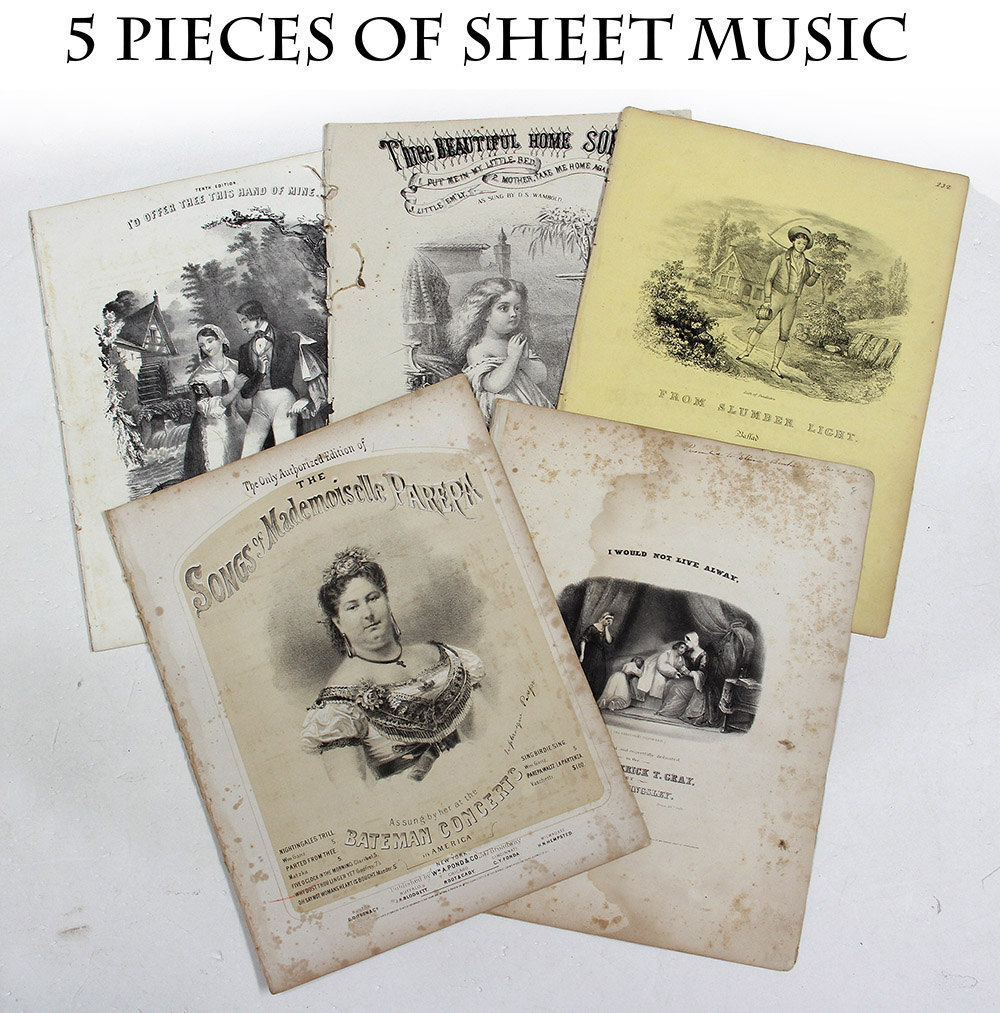
16-04-25 … SHEET MUSIC WITH GOOD GRAPHICS … LOT OF 5! … “Songs of Madamoiselle Parepa” and 4 other lots pictured here. You can be the first one on your block to introduce these CW tunes to the neighborhood. They tend toward the romantic and sentimental. Many are reminders of the fragility of life in nineteenth century America, and they would look good framed or even in a collection as examples of life on the homefront. There are certainly many stories in soldier letters of visits to local houses during lulls in campaigning where singing in the parlor was a welcome break in army life. For those stationed on the frontier it was one of the few wholesome recreations available to stave off boredom. Each piece has a nice cover graphic … noco … $70.00
Call us @ 419-842-1863
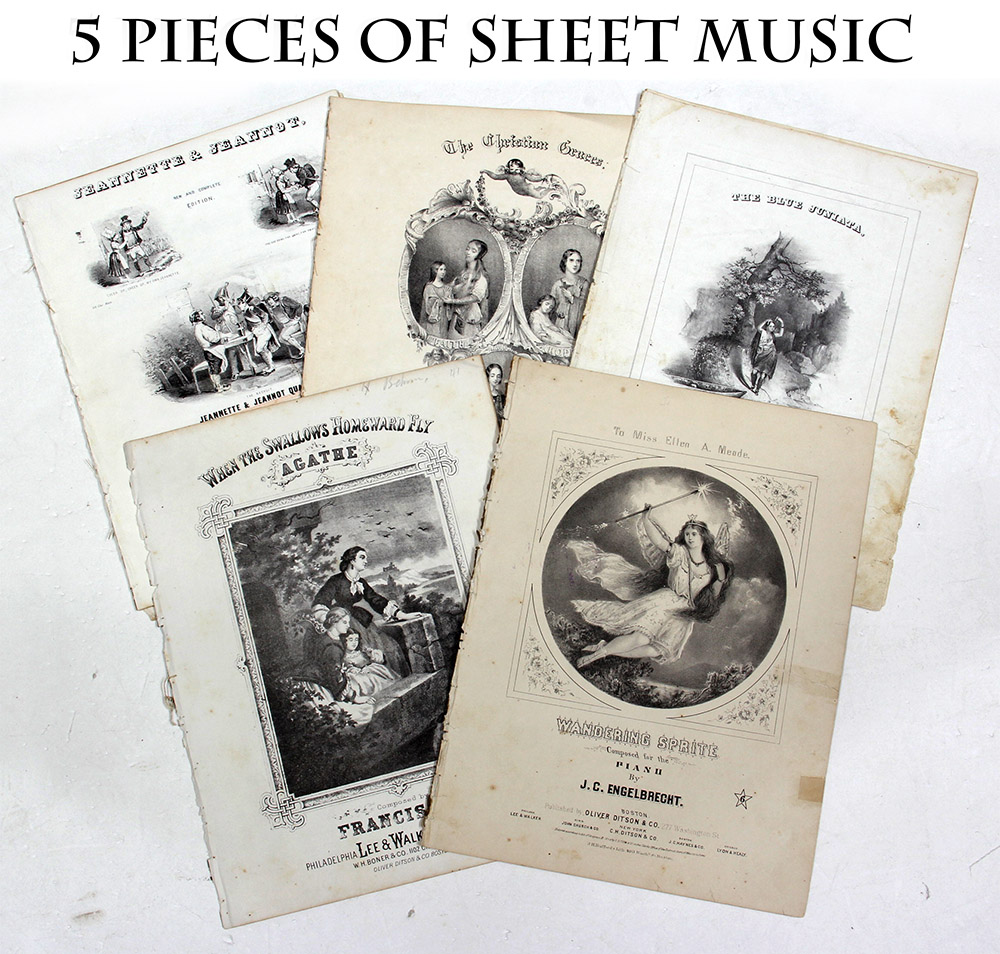
16-04-26 … SHEET MUSIC WITH GOOD GRAPHICS … LOT OF 5! … “When the Swallows Homeward Fly” and 4 other lots pictured here. You can be the first one on your block to introduce these CW tunes to the neighborhood. They tend toward the romantic and sentimental. Many are reminders of the fragility of life in nineteenth century America, and they would look good framed or even in a collection as examples of life on the homefront. There are certainly many stories in soldier letters of visits to local houses during lulls in campaigning where singing in the parlor was a welcome break in army life. For those stationed on the frontier it was one of the few wholesome recreations available to stave off boredom. Each piece has a nice cover graphic … noco … $70.00
Call us @ 419-842-1863
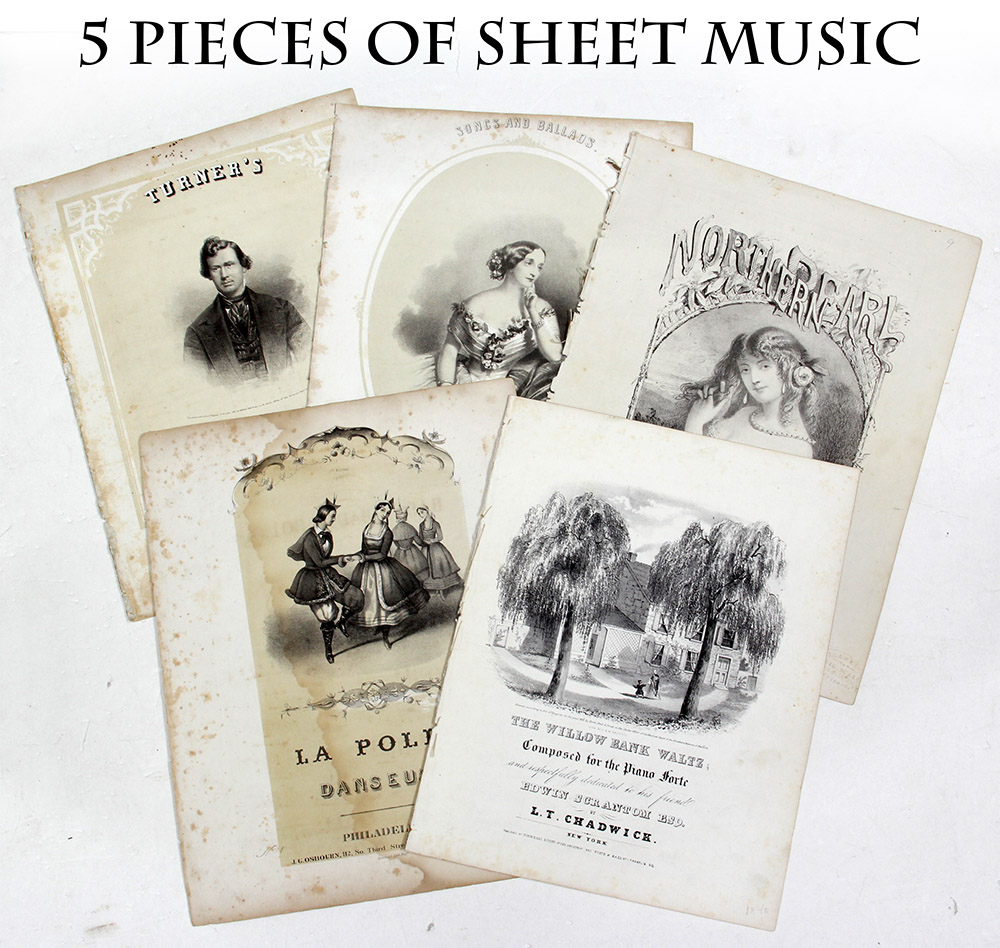
16-04-27 … SHEET MUSIC WITH GOOD GRAPHICS … LOT OF 5! … “The Willow Bank Waltz” and 4 other lots pictured here. You can be the first one on your block to introduce these CW tunes to the neighborhood. They tend toward the romantic and sentimental. Many are reminders of the fragility of life in nineteenth century America, and they would look good framed or even in a collection as examples of life on the homefront. There are certainly many stories in soldier letters of visits to local houses during lulls in campaigning where singing in the parlor was a welcome break in army life. For those stationed on the frontier it was one of the few wholesome recreations available to stave off boredom. Each piece has a nice cover graphic … noco … $70.00
Call us @ 419-842-1863
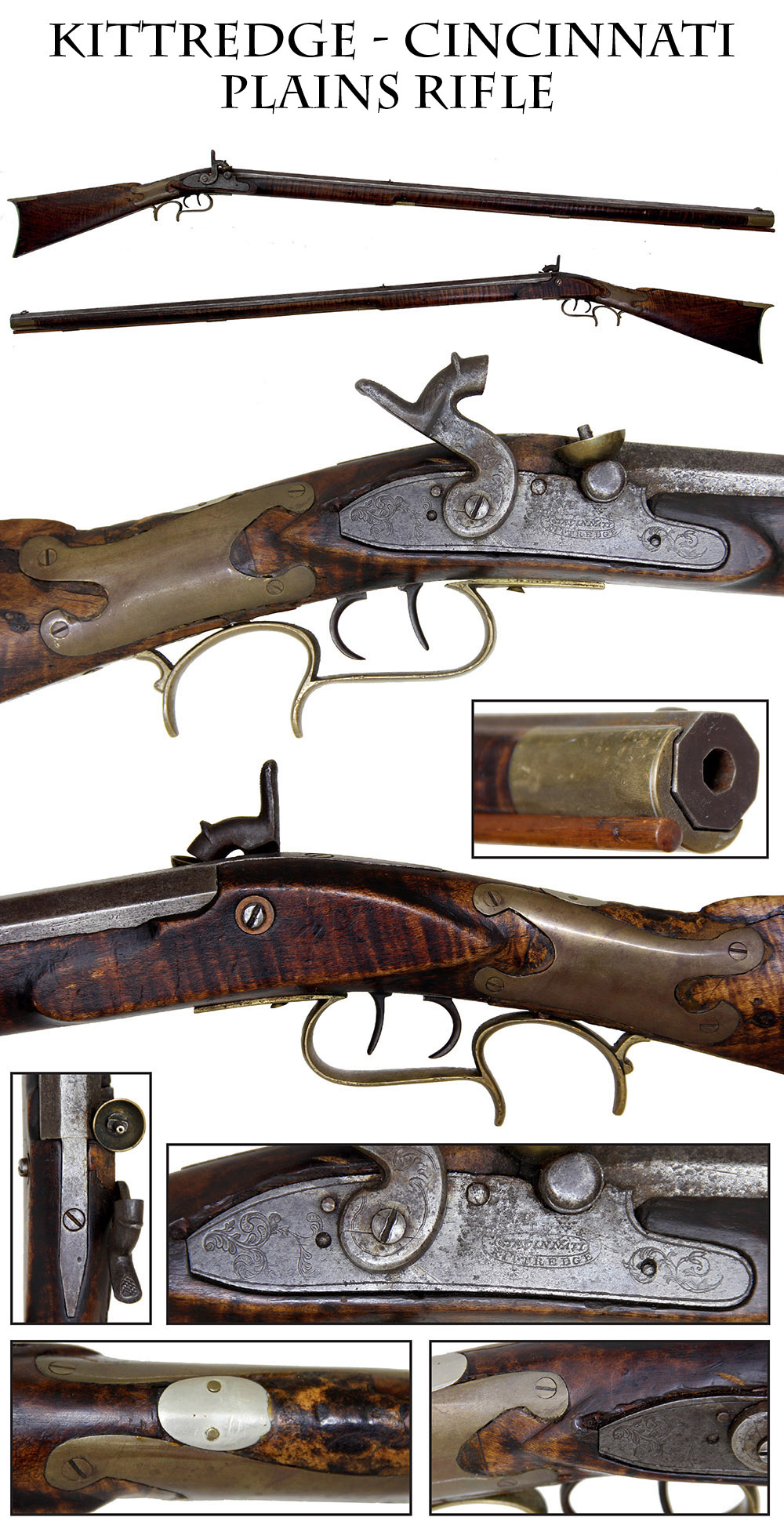
16-04-28 … KITTREDGE PLAINS RIFLE … Cincinnati was the gateway to the west in the 1840s and 50s, and Ben Kittredge was one of the big suppliers of weapons and gear to the early frontiersmen. Charles Kittridge (relationship unknown) also had an office in Saint Louis. So Between Ben Kittredge and Charles Kittredge, they were selling a pile of guns going west, not to mention Ben’s connections in New Orleans. This rifle is a nice example of one of his full-stocked, double-set trigger plains rifles. It is roughly .36 caliber with decent rifling in the bore covered with surface rust. The wood is handsomely stained to resemble the curly maple of Pennsylvania-Kentucky rifles and is capped at the muzzle with a brass nosecap. It has a recurved brass trigger guard and butt plate, with a German silver oval wrist escutcheon. An old wrist break was carefully and artfully mended during the period to keep the gun in use: a curving and elongated H-shaped plate was screwed in at either side, the rounding and curves of its arms rather adding to the appeal of the rifle. A wonderfully American folk-art repair. Front sight and rear block sight in place. Nicely engraved and legible lockplate with foliate swirls fore and aft, and a clear “Cincinnati / Kittredge” stamp in an oval just below the side lug. Smooth metal to the barrel, mostly a light gray with some bright areas. The user also had fitted a brass cupped flash shield to reduce burnout of the surrounding wood, corrosion to the barrel, and flying pieces of percussion cap. Mechanically good. A genuine frontier plains rifle from a noted maker and dealer, priced most affordably … 38″ barrel … ycej-rpal … $535.00 – SOLD
Call us @ 419-842-1863
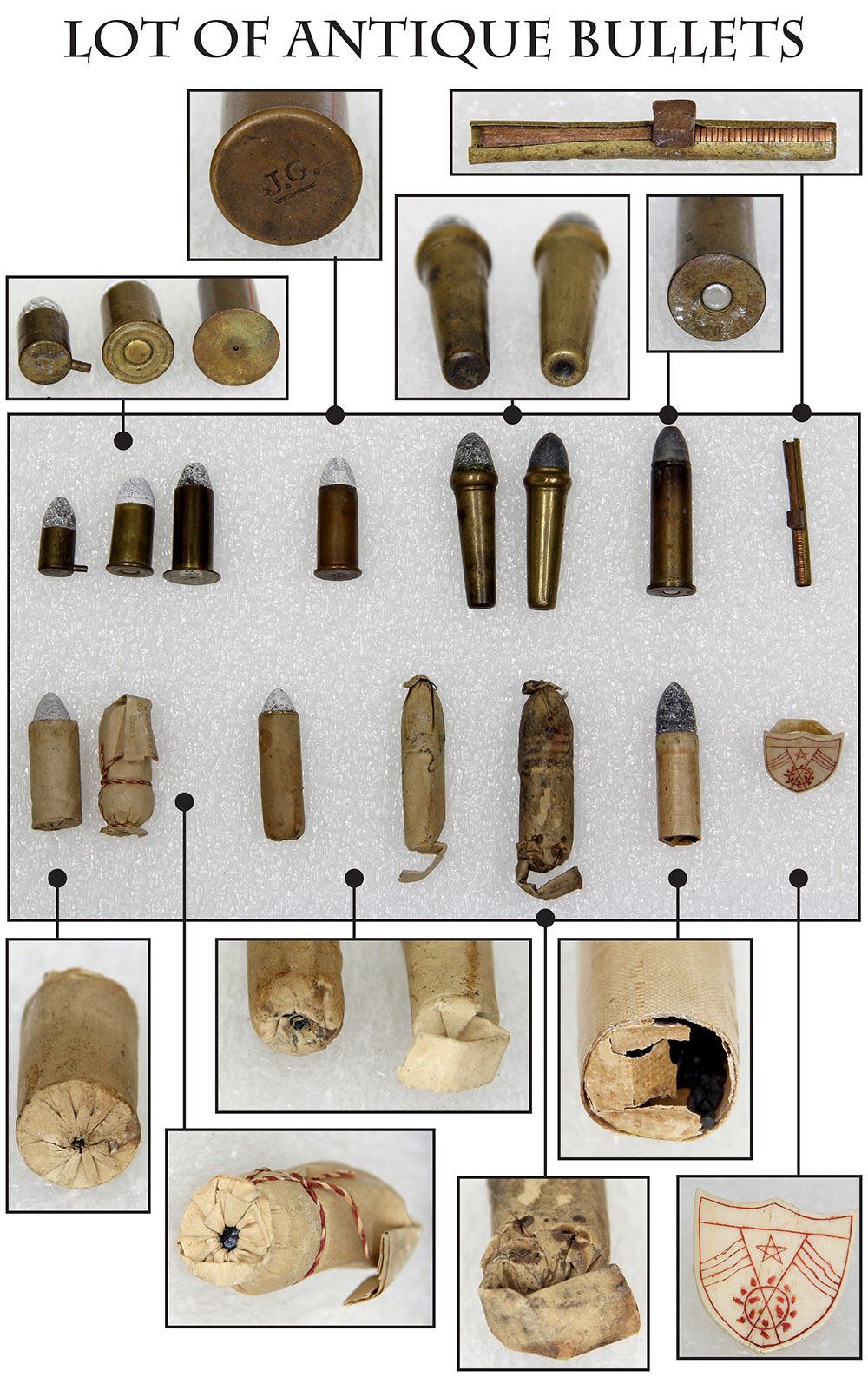
16-04-29A … MIXED LOT OF CARTRIDGES … Dealer lot of fourteen (14) various antique cartridges and a tube of Sharps priming pellets. Starting at the top right we have a pinfire cartridge for Lefaucheux, then a .50 caliber center fire cartridge , and a Maynard carbine cartridge. The next is a Spencer cartridge, then two Burnside cartridges, then a big long 50 caliber center fire cartridge, and a partially full tube of Sharps pellet primers finishes off the top row. The bottom row from left to right Smith carbine, Hall Carbine, Gallager carbine, 54 or 58 rifle paper wrapped musket cartridge, huge 69 or 72 caliber paper wrapped musket cartridge, and finally a Sharps cartridge missing the powder. The bone carved item is NOT part of this lot. All for one money as they say…. Guaranteed to be easily worth over $700 if sold separately, perhaps more as I don’t know what guns the center fire cartridges fit and I’m not in the mood to research them … $550.00 – SOLD
16-04-29B … SOLDIERS BONE NECKERCHIEF SLIDE … One of the popular camp pastimes was carving rings, neckerchief slides and the like from the many bones available from the cattle slaughtered to feed the army. These became popular gifts for the folks back home, trade goods for civilian visitors, and in the case of prisoners of war a valuable commodity for trade for food, supplies and favors. The soldier carved this one in the shape of a shield, and then incised and filled in with a red paint or wax, an outer border and a five-pointed star at top, flanked by two US flags (rendered just as some stripes, but enough to make the point in a small format, with a wreath (likely meant to be a laurel wreath of victory) circling the intersection of the flag staffs. The slide ring is present and unbroken. A very nice example of Civil War soldier camp art … noco … $165.00
Call us @ 419-842-1863

16-04-30 … CDV STANDING VIEW OF A 7th NEW YORK SOLDIER … Crisp early war view by Fredericks, New York, of a member of the 7th New York State Militia, one of the very early-war northern regiments rushed to Washington in 1861. Led by Colonel Marshall Lefferts, the regiment federalized three times. The first on April 19, 1861, just days after Fort Sumter. It mustered in for thirty days and served in Washington. In May, 1862, it went in again, for three months, and was stationed for most of that period in Baltimore. In June, 1863, it mustered in for another thirty days during the Gettysburg campaign, served at Baltimore and Frederick, Maryland, and then returned to New York City to help put down the draft riots in July. Our man holds his rifle at parade rest with bayonet fixed and has his overcoat thrown over one shoulder, showing its colored lining (the 7th NY had them lined in red.) He wears a low crowned cap with a “7” inside a hunting horn on the front, and around his waist seems to be an NCO belt, though no chevrons or pants stripes are visible. He has a serious look and a fashionable set of muttonchop sideburns with his moustache, giving him the appearance of a well-heeled member of that exclusive militia regiment. The fact he is wearing his overcoat suggests we are looking at an image of their first mobilization, when they rushed south to save the nation’s capital. A stong early war image … $295.00
Call us @ 419-842-1863
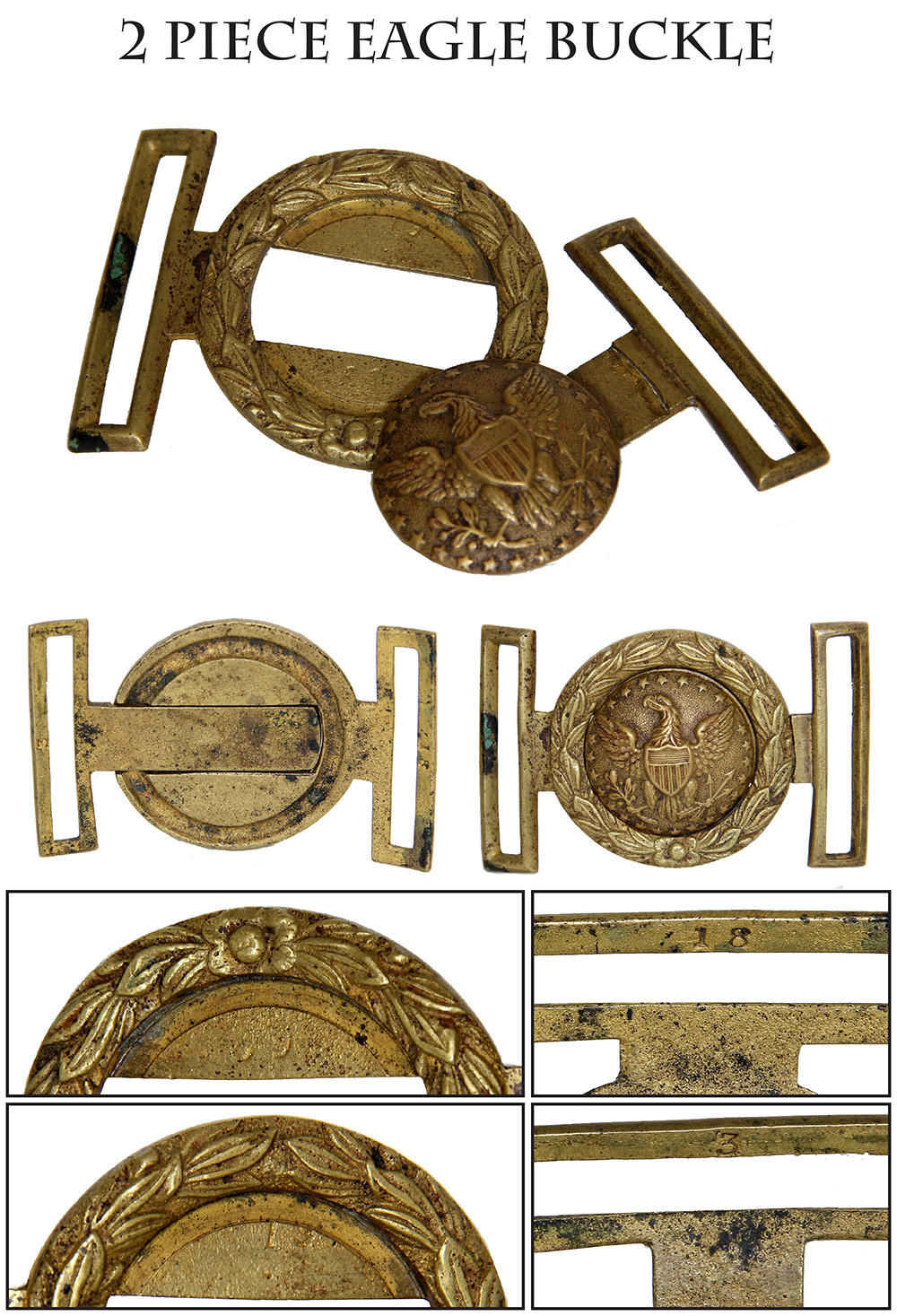
16-04-31 … Beautiful Eagle Motif Tongue Wreath 2-Piece Interlocking Buckle: My favorite form of waist belt plate is this interlocking tongue and wreath design. This specimen is absolutely stunning in terms of die work and condition. The federal eagle is on a lined field and surrounded by stars. The wreath is a finely executed laurel wreath design Circa 1845 and perfect for display with early war US or Confederate effects. The fit is nice and batch number markings are still legible on both parts. I have owned a few examples over the years and this is an extra pretty one …
bjj-tvdbcxvz-12520 … $795.00 – SOLD
Call us @ 419-842-1863
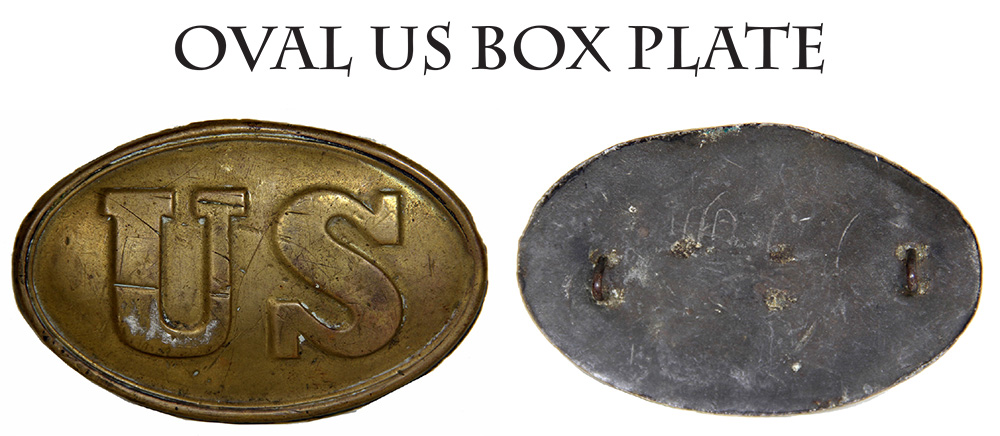
16-04-32 … Oval US Boxplate … Identical to the US oval buckles, but having two iron wire loops on the back for securing to the flap of the cartridge box. Fine non-dug condition … adj … $225.00
Call us @ 419-842-1863
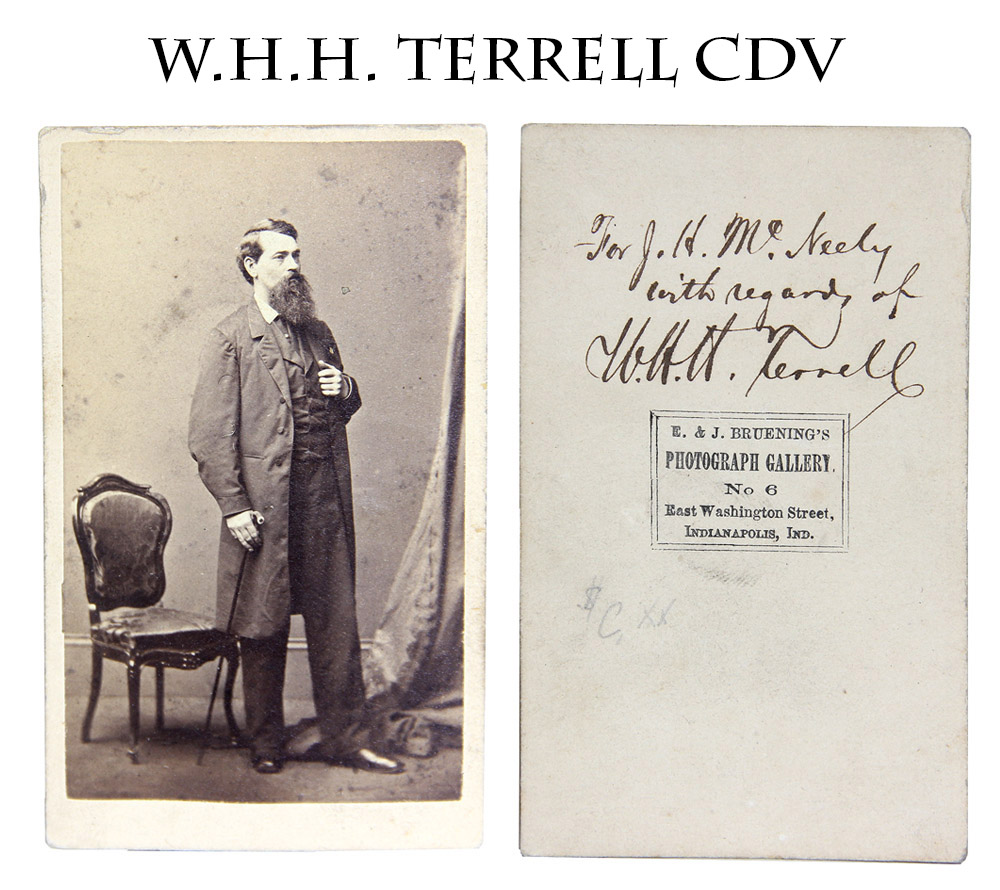
16-04-33 … INDIANA ADJUTANT GENERAL WILLIAM H.H. TERRELL …
Very elegant pose, full standing, one hand grasping his lapel, the other holding a walking stick. Nicely signed in ink on reverse: “For J.H. McNeely with regards of W.H.H. Terrell.” Breunig, Indianapolis backmark. William Henry Harrison Terrell (1827-1884) was a former clerk, auditor, newspaper editor, lawyer and bank cashier, who was intimately involved with military affairs of the state. As a member of the Finance Department his correspondence included dealings with men such as John Wilder of the Lightning Brigade. He became the state’s Adjutant General in 1864 and served until 1869. He is best known as author of the eight volume set “Indiana in the War of the Rebellion,” a key resource for anyone interested in the state’s role in the war. In 1869 Grant appointed him as Third Assistant Postmaster General, a position he held for four years. An important figure in keeping one of the larger northern states in the fight. Historical Indiana Photo… autographed … $100.00 – SOLD
Call us @ 419-842-1863
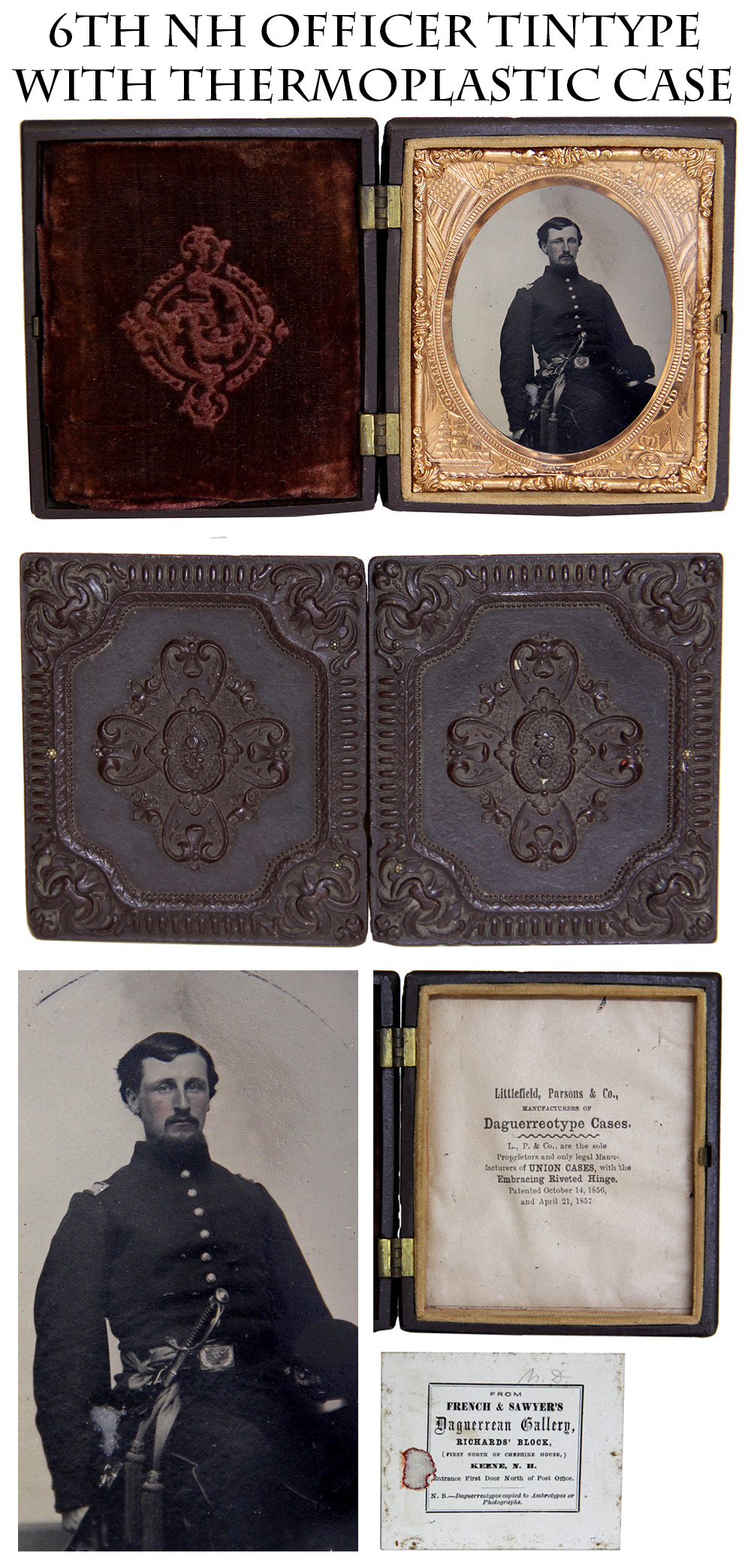
16-04-34 … ARMED 6th NEW HAMPSHIRE OFFICER TINTYPE … Ultra Crisp and Clear sixth plate tintype of an infantry second lieutenant in his regulation frock coat with shoulder straps, officer’s sash and sword belt. At his side is his 1850 foot officer’s sword and he holds his forage cap showing a prominent infantry officer’s hunting horn insignia with a numeral “6” inside the loop on the horn. The officer’s cheeks have been delicately tinted and the clarity of the image is wonderful. There is a small scuff on the officer’s sleeve, otherwise about mint. The image is cased in a Littlefield, Parsons and Company Union case with floral motifs and just a few tiny edge bumps. On the back of the tintype is a label from “French and Sawyer’s Daguerrean Gallery” of Keene, New Hampshire. The Sixth New Hampshire, which fought in the 9th Corps, organized in Keene. Here is a list of their engagements …
Camden, N.C. … … … …. … …….. … … … … … … Apr. 19, 1862
Bull Run, Va. … … … …….. … .. . … … … … … … . Aug. 29, 30, 1862
Chantilly, Va. … … … … … …. … ….. .. … … … … . Sept. 1, 1862
South Mountain, Md. ….. … ….. . … …. … … … …. Sept. 14, 1862
Antietam, Md. … … … … ….. … ……. … … … … ….Sept. 17, 1862
White Sulphur Springs, Va. …… … ….. …. … … … .Nov. 15, 1862
Fredericksburg, Va. … … … ….. … ….. . … … … … Dec. 13, 1862
Siege of Vicksburg, Miss. … … … ….. … … … … … June 14 to July 4, 1863
Jackson, Miss. … … … … …. … ….. .. … … … … … July 10-16, 1863
Wilderness, Va. … … … … … ….. … ……. … … … ..May 6, 1864
Spottsylvania, Va. … … … … … ….. … ….. . … … …May 8-20, 1864
North Anna River, Va. … …. … ……… … .. … … … May 23-26, 1864
Totopotomoy, Va. … … …. … …. … …….. … … … .May 30,31, 1864
Bethesda Church, Va. … …. … …. … …….. … … … June 2,3, 1864
Cold Harbor, Va. … … … …. … …. … ….. … … … ..June 4-12, 1864
Siege of Petersburg, Va., … ….. … … … … … ….. …June 16, 1864 to Apr 3, 1865
Mine Explosion, Petersburg, Va. (assault) …. … …. July 30, 1864
Weldon Railroad, Va. … … …… … .. … … … … … .Aug. 20-22, 1864
Poplar Springs Church, Va. … …… … .. … … … … Sept. 30, Oct. 1, 1864
Hatcher’s Run, Va. … … … … … … ….. … … … … .Oct. 27, 1864
Petersburg, Va. … … … … … … … … … … … … … Apr. 1, 2, 1865
A fine historical Civil War image … cjj … $450.00 – SOLD
Call us @ 419-842-1863
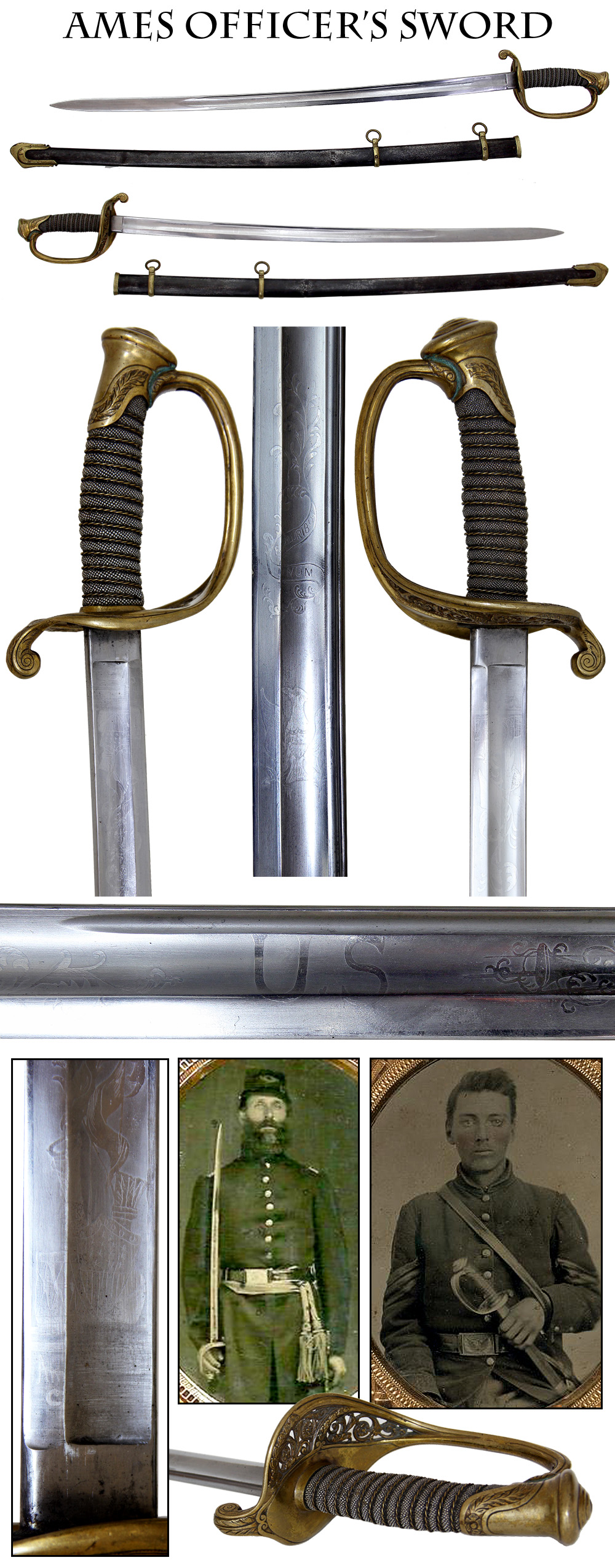
16-04-35 … AMES FOOT OFFICER’S SWORD IN EARLY WAR AMES METAL SCABBARD … The regulation Civil War infantry line officer’s sword. Carried by lieutenants and captains, this pattern was adopted from the French and introduced into US regulations in 1850. Complete sharkskin grip and wire, untouched brass hilt. Blade is bright with delicate etching of floral motifs, an American eagle and national motto on one side and a “US” on the other. Slightly rubbed but visible above the ricasso on one side is the Ames / Chicopee logo etched just beneath a patriotic American shield and assortment of arms. Very few Ames foot officer’s swords are found in steel scabbards. Most came with leather sheaths. This is a very rare and early pattern Ames brass mounted steel scabbard in VG solid condition. The blade is very nice, no nicks. The scabbard drag shows it was actually worn in the field- the drag is worn down slightly from occasionally dragging along the ground when the officer neglected to place it on the carrying hook of his sword belt. A nice variation of the regulation foot officer’s sword worthy of a Civil War or Amercian edged weapons collection or even the more specialized Ames collection. Compare the same sword at $1650 on the Gutterman page … g-15491 … $1,150.00 – SOLD
Call us @ 419-842-1863
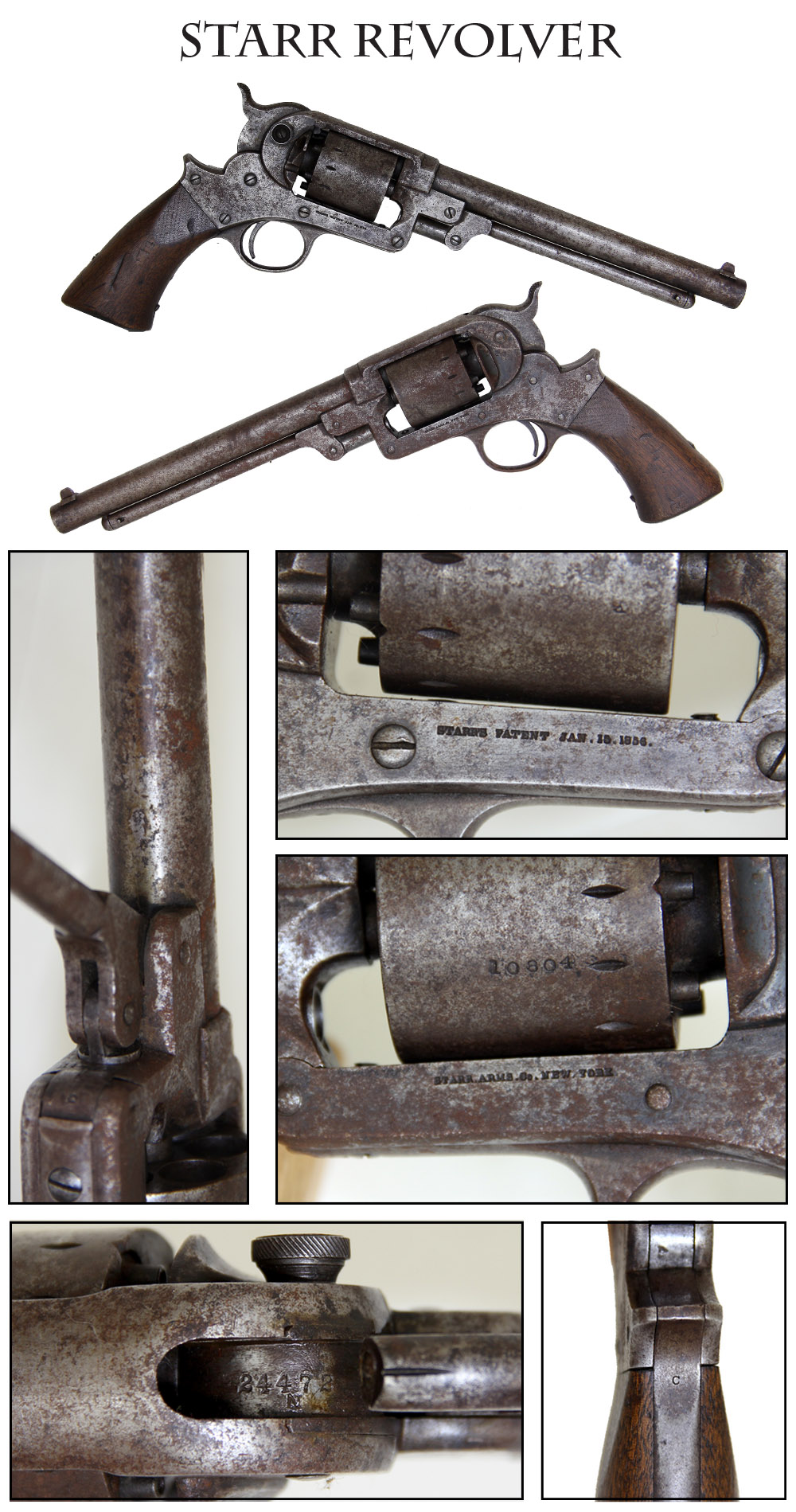
16-04-36 … 16-02-34 … SINGLE ACTION STARR ARMY REVOLVER … The Starr double actions were too far ahead of their time- at the very least the trigger pull would throw off any chance of hitting your target. The single action was more conventional and replaced it mid-war. This one was obviously “ridden hard and put away wet,” showing gray underneath a generous surface dusting of brown. Much of this would clean easily, but of course most of the bluing is long gone. Still, the markings are crisp and the wood, though it has some dings, still has a tight fit and shows a visible cartouche. The cylinder shows serial number 10804 and the loading assembly 24472, so the gun was plainly issued and the assembly switched over a campfire cleaning. I see mixed numbers on these stars about 35% of the time. Overall a solid “gun metal grey” gun … h-1/2-szym … $1,075.00 – SOLD
Call us @ 419-842-1863
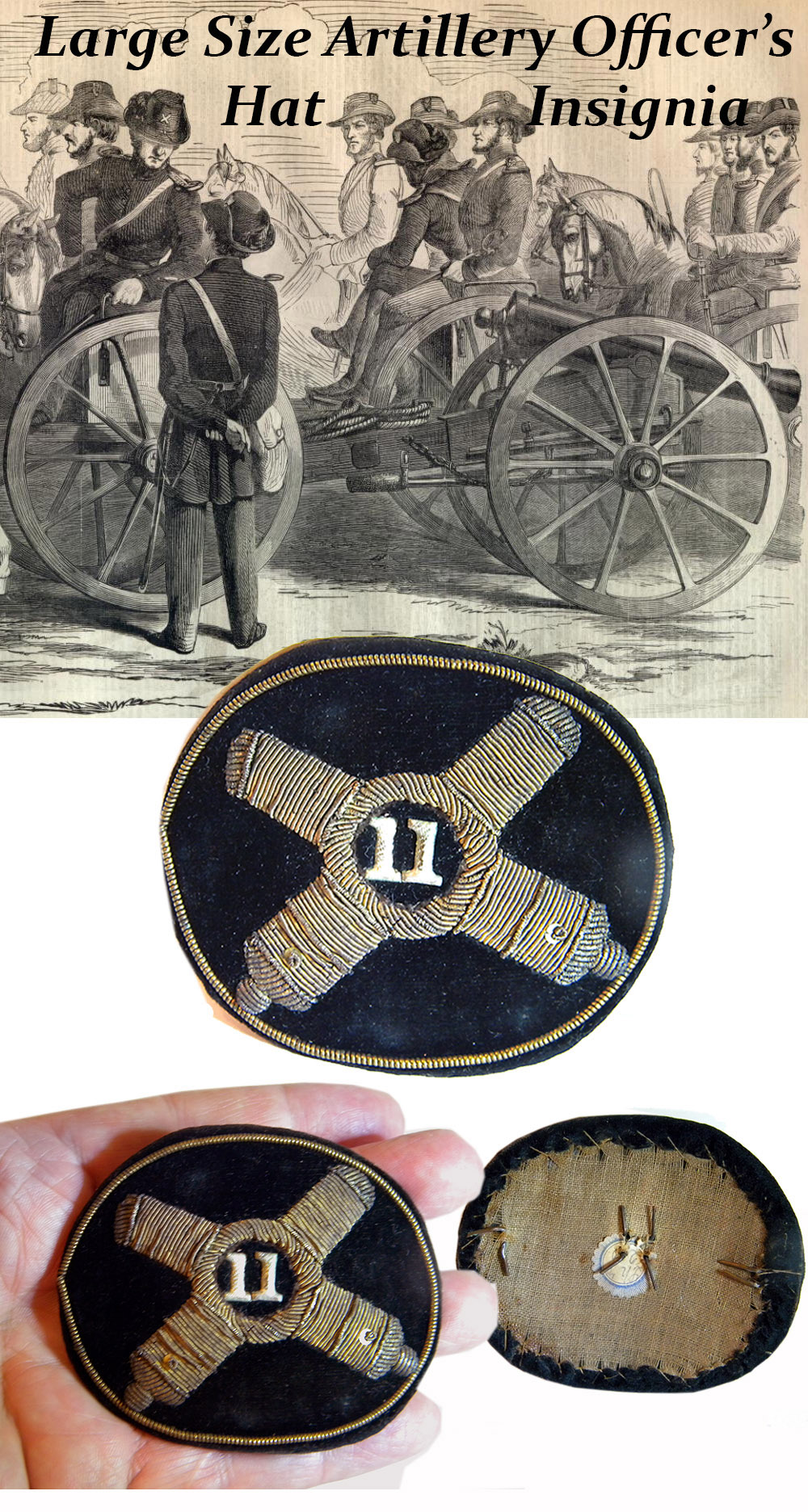
16-04-37 … MAGNIFICENT GOLD EMBROIDERED ARTILLERY OFFICER’S CROSSED CANNON HAT INSIGNIA … All Civil War embroidered hat insignia is scarce. Cavalry is much scarcer than infantry. Artillery is much scarcer than cavalry. This piece is top drawer in all respects. It is very large measuring over 3 inches across and 2 1/2 inches tall. The embroidery is executed on fine black velvet that has turned slightly brown with age. The wire edge border is intact. The velvet is sewn around an interior oval tin stiffener, and this stiffener is covered on the back with brown polished cotton. Inside the loop on the face are false embroidered stamped numerals 11. This could represent the 11th NY Artillery, the 11th US Colored Artillery, but more likely represents the 11th independent battery of “pick a state” as there were a lot more 11th independent batteries in the several states, than there were 11th regiments. Brass attaching wires are present on the back. Condition is extra fine … among the best available. One of the best pieces I’ve come up with in recent memory … $850.00
Call us @ 419-842-1863

16-04-38 … Interesting CDV of “Fisherman at Work” … Photos of people smiling during this period are very unusual. Portraiture by photography was regarded by many as a formal presentation of oneself to the world with no room for frivolity. This fellow, however, was happy in his work: “The ‘Fisherman’ at work, fishing on land. Stringing a big “fish” for the college,” according to the printed caption pasted on the reverse. This cheerful bearded fellow sits a marble top table with inkwell close to the camera and pen in hand, apparently writing a letter on a portable writing desk he has set out on the table. Fitting the printed caption is a portrait of a fish on the lid of his writing box, that he displays for the camera. The allusion to being “a fisher of men” seems pretty clear and the reference to a college then implies a religious institution, though “stringing a big ‘fish’ for the college,” may refer to securing a donor for a school or something of that sort. If he is, indeed, an educator it might be possible to identify him. The printed caption suggests there are more images of him out there. There is a good story here in any case and it’s an intriguing and entertaining photo … ee … $85.00
Call us @ 419-842-1863

16-04-39 … LEFT HANDED FRENCH PERCUSSION PISTOL … Elaborate French percussion pistol with a left handed lock. Perhaps made specifically for a left-handed customer, or perhaps one of a pair made with left and right locks for display. In any case, a well made single shot pistol likely dating to the First Empire and then converted to percussion in the 1820s or 30s. Typical French steep drop to the grip with an octagonal facetted butt cap. Checkered and beaded grip and edge to the lock apron. The elongated lockplate shows it was once flintlock, but converted to percussion, perhaps by the same gunsmith who first made it: the cutout for the pan and screw holes for the external parts have been very professionally filled and are hardly visible. The breechplug tang is engraved and the screwhead shows both decorative engraving and some original blue. Two very decorative silver escutcheon sideplates secure the lock screws, the rear one having animal heads (a dog or wolf) arranged back to back on either side of the screw. The triggerguard, triggerguard tang and entry pipe for the rammer are likewise delicately engraved with scrolls and urns. The barrel is gray with scattered browning and faint trace of color. The muzzle is nicely swamped. The hammer shows finely detailed engraving. The front sight is in place and there is a short adjustable rear sight. This pistol was definitely meant for business. The trigger is fitted with a set screw. The bone tipped rammer appears to be a replacement. Lockplate engraved by the maker, “????? a Mayenne.” A very high quality piece of workmanship … e-tietj-160409 … $775.00
Call us @ 419-842-1863
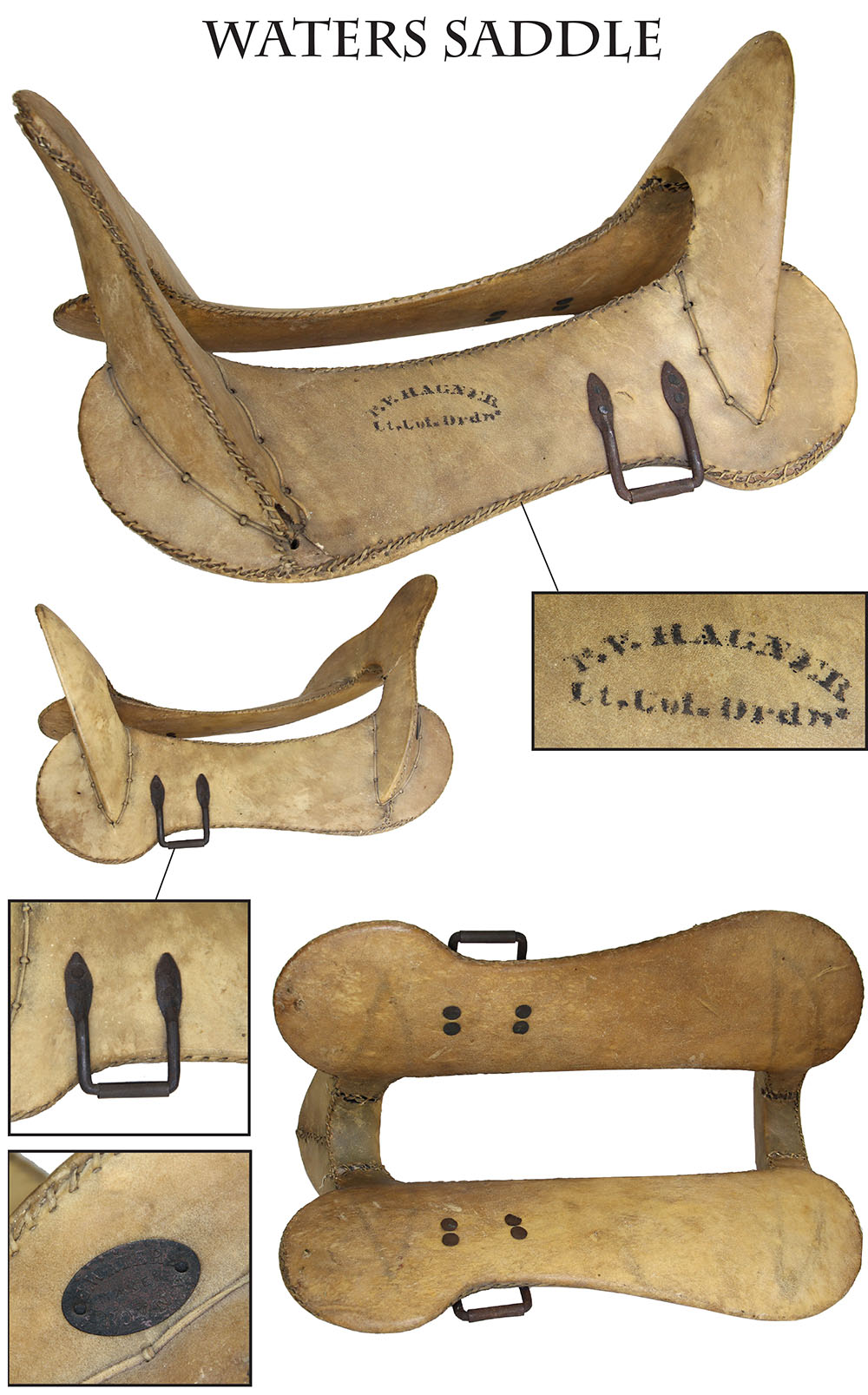
16-04-40 … CIVIL WAR ARTILLERY DRIVER’S SADDLE TREE … Horse-drawn artillery required special saddles to fit the harness set up for six horses to draw the guns, limbers, and caissons. Civil War batteries used Grimsley pattern saddles for both the driver and valise saddles. (Each pair of horses on the gun teams had a driver mounted on the left who controlled his mount and the horse on his right, which bore a smaller Grimsley pattern saddle used just to hold the driver’s valise.) This is an original wartime driver’s saddle tree with its full rawhide cover in place and the stirrup loops. In excellent condition, it bears the brass maker’s tag of E. Waters of Troy, N.Y. and the ink inspector’s stamp of “P.V. Hagner / Lt. Col. Ordn.” Hagner supervised the Watervliet Arsenal starting in late 1863. The facility was one of the main points of supply for artillery gear to the Union army and Waters apparently supplied saddle trees, which would then be finished with their outer leather, brass trim and padded seats. The government toughened up its requirements for contractors labeling their products as the war went on and Waters used the same sort of brass tag that would appear on the outside of a finished saddle to mark his products. This is a top notch example showing how these saddles were actually put together, just as it arrived at the arsenal … noco … $375.00 – SOLD
Call us @ 419-842-1863

16-04-41 … SMITH AND WESSON NUMBER 2 ARMY MARKETED BY A FRENCH DEALER … Smith and Wesson .32 rimfire No. 2 Army, serial number 65780, placing it after the war ended, but showing the continued popularity of the pistol. (No need to recite all the American westerners who carried them- Custer… Hickok…. Etc… etc…) This one made it to France and bears a French dealer’s name in script on one side flat, and his Paris address on the other. The first such marking I have encountered. The barrel retains about 30% blue mixed with some darker areas. The blue is stronger on the frame and the grips show off well, with some dings and lines, but a nice even dark color. Correct Smith and Wesson barrel markings and serial number on the buttstrap, with one fine hairline of the bottom of the butt and some mottling to the varnish. An interesting S&W variant that could have seen service in the Franco Prussian War … d-17068 … $675.00 – SOLD
Call us @ 419-842-1863

16-04-42 … REPRODUCTION CARTRIDGE BOX SLING AND PLATE … This came in with a mixed lot of material and is a good copy of a Civil War sling ready to go on a reproduction box or act as a place holder on an original box until a suitable real one shows up. Needs a little cleaning, or dirtying up, to match your box, but is fairly supple and will complete an outfit nicely …
noco … $10.00 – SOLD
Call us @ 419-842-1863
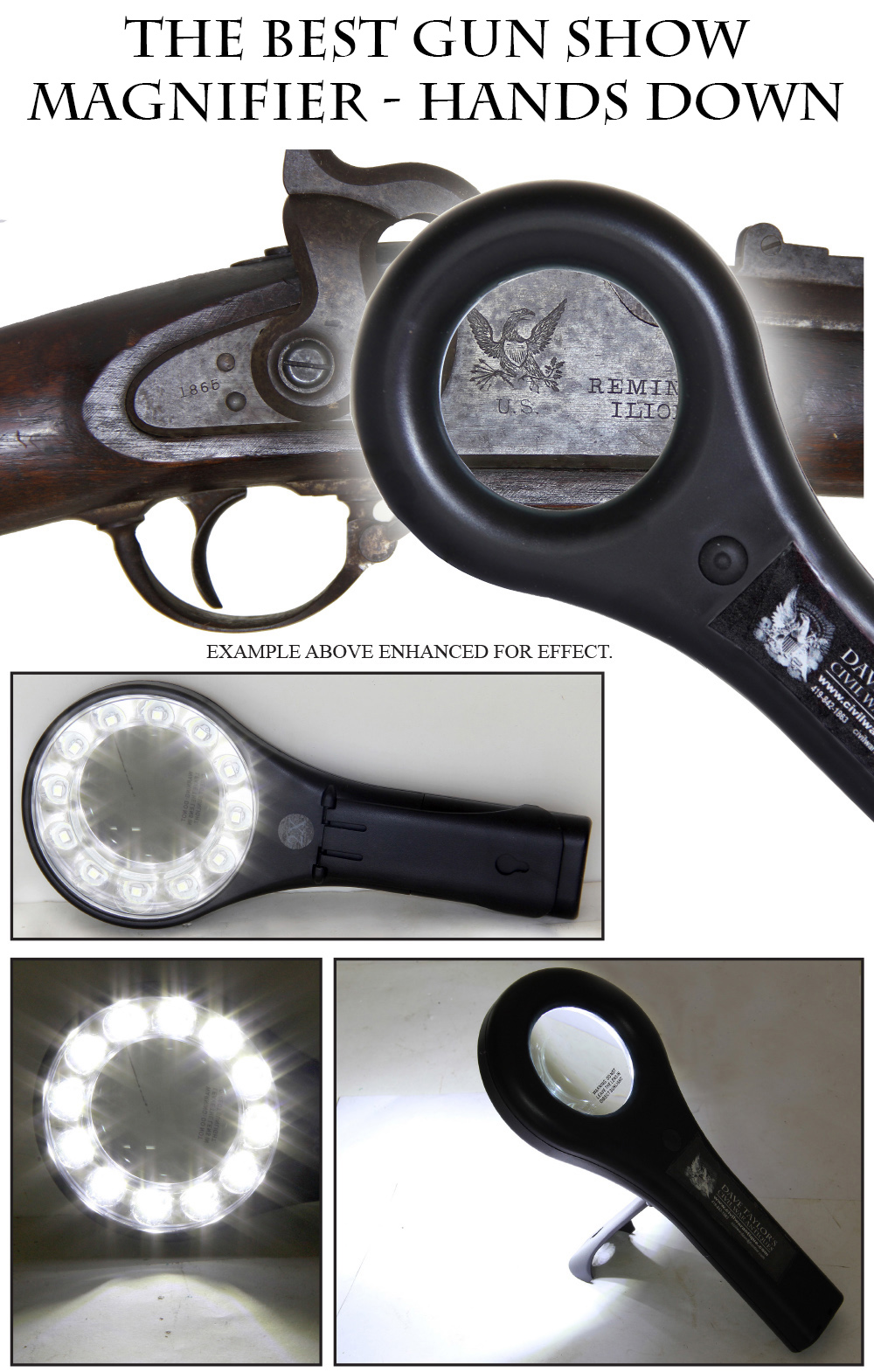
16-04-43 … INCREDIBLY EFFECTIVE LIGHTED MAGNIFYING GLASS / PERFECT FOR INSPECTING ANTIQUES … You have undoubtedly seen collectors at the shows running around with one of these magnifying glasses in their hand. There’s a good reason … they are SUPER! Months ago I bought one for myself and loved it. Then the local guys wanted one and I bought another half dozen for them at $25 each at the next show … Then I bought another one for me when I arrived at a show and discovered I’d left mine at home. I figured with as many as I was buying at retail, I might as well buy them in bulk and sell them at the shows and on the web page. These are absolutely essential for anyone buying antiques at shows or auctions. The intense illumination from the twelve LED light sources and 2x magnification exposes “artificial age” such as cold-blue on metal or amber shellac on wood. Shine this light and you will see if someone has “aged” or repaired the item you wish to buy. The magnification accompanied by the intense illumination reveals cracks and repairs that the naked eye cannot pick up. Requires 3 AA batteries (not included) … $25.00
Call us @ 419-842-1863
Layaways are Welcome
Need to split your order into multiple payments? No problem! A simple 20% earnest money deposit will hold your item for you.-acf
You can then pay it off in easy installments that fit your budget.
Read Terms Here
Items to Sell? Contact Us
I am always interested in buying ANYTHING from the American Civil War… Guns, Swords, Civil War Muskets, Knives, Uniforms, Flags, Medals, Badges, Diaries, Letters, Autographs, Buttons, photographs, tintypes, daguerreotypes, Insignia, Camp Items, Battlefield Relics, canteens, Drums, Etc… Call 419-842-1863 and ask for Dave Taylor.

